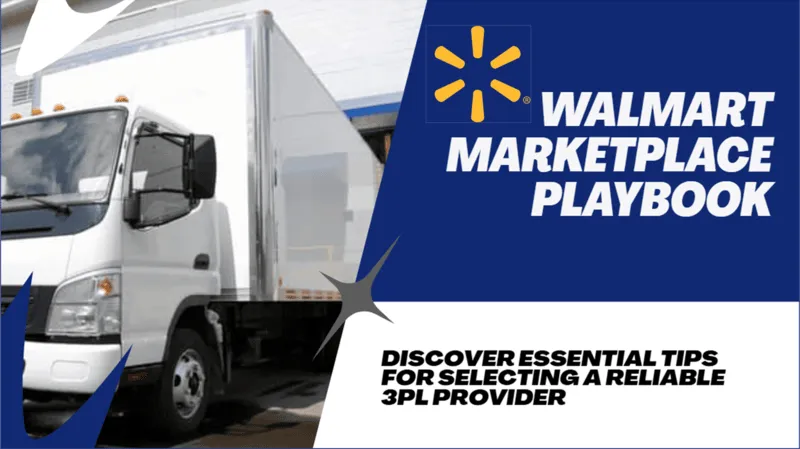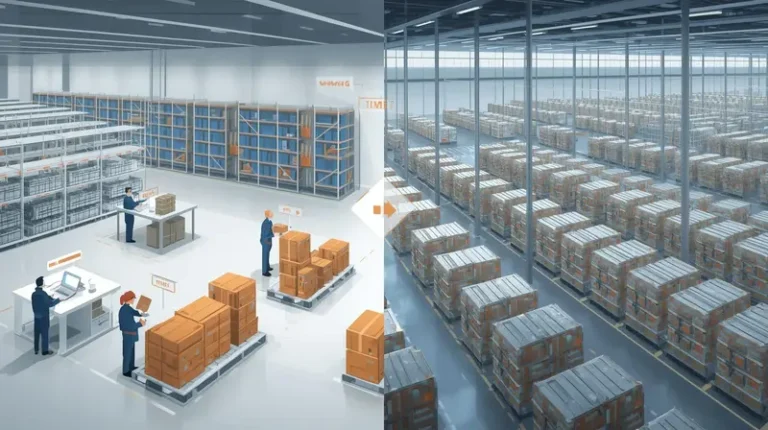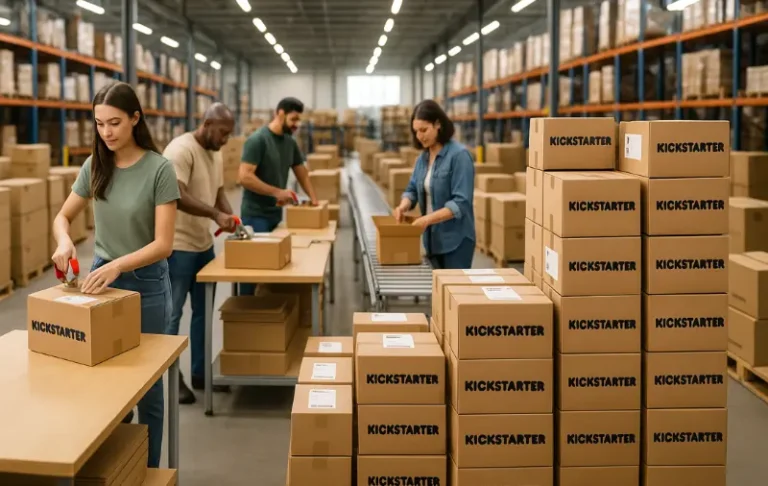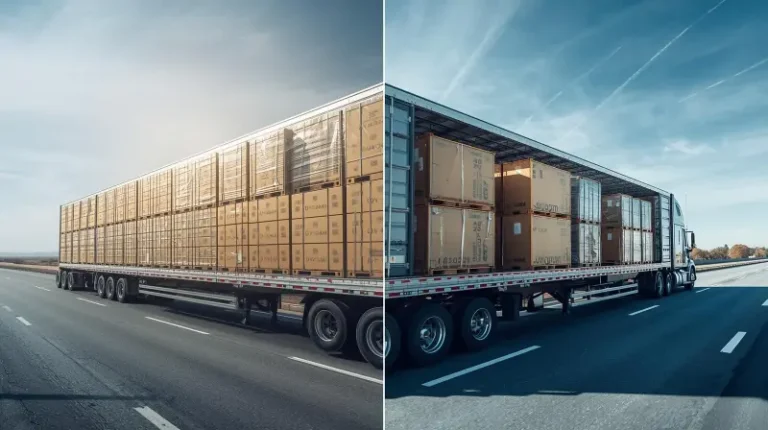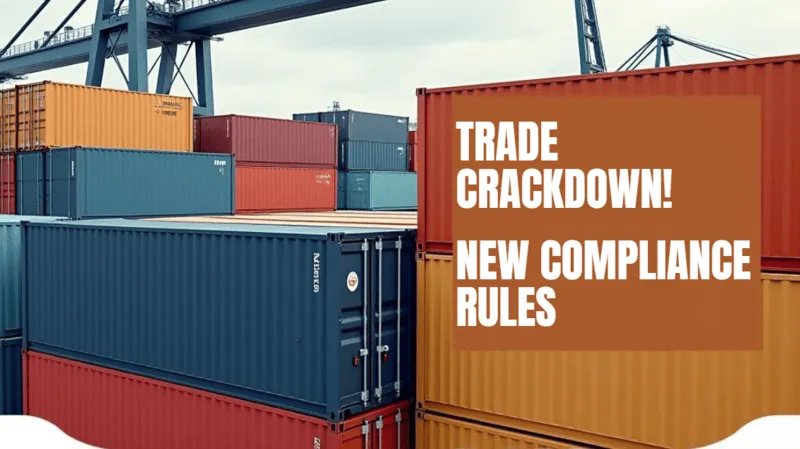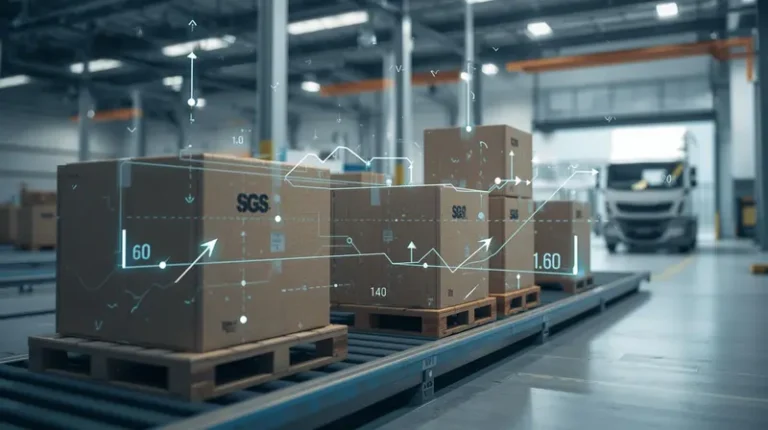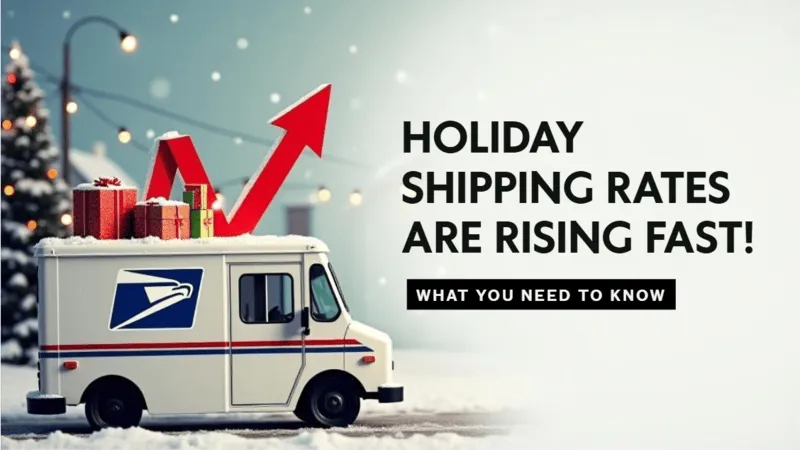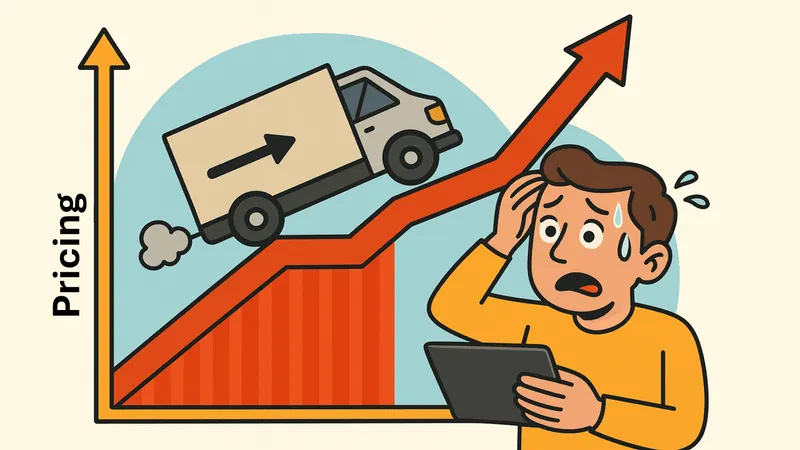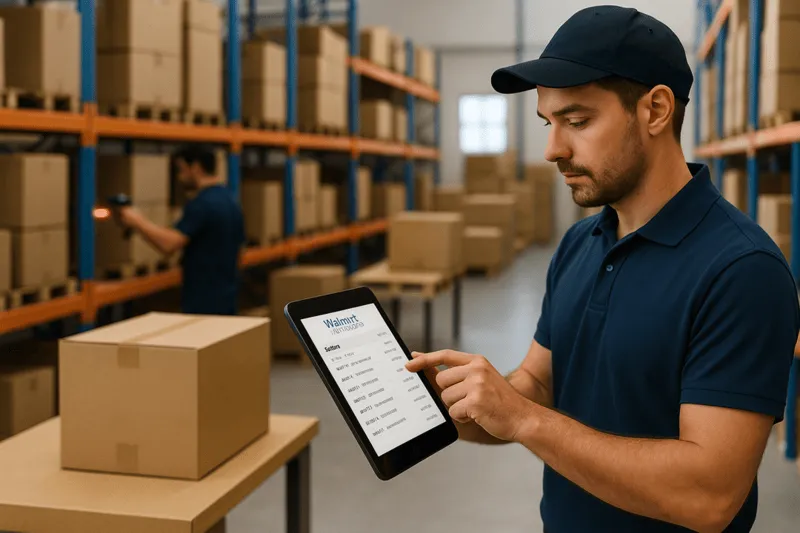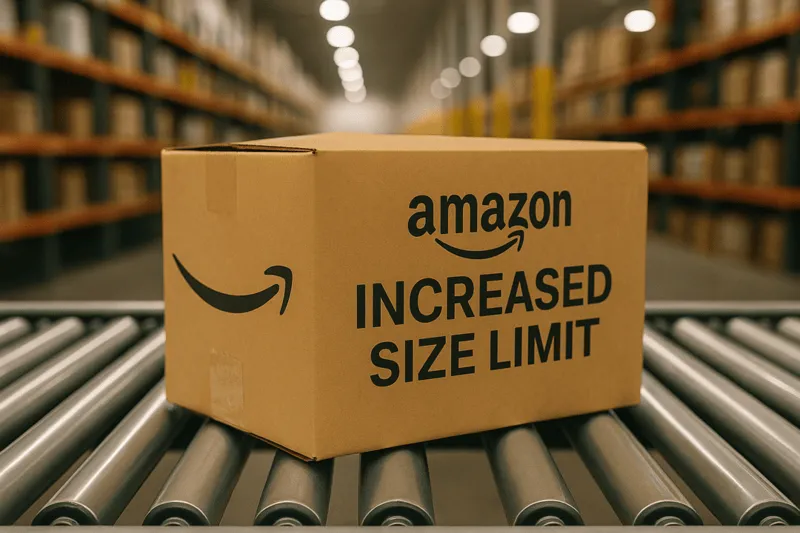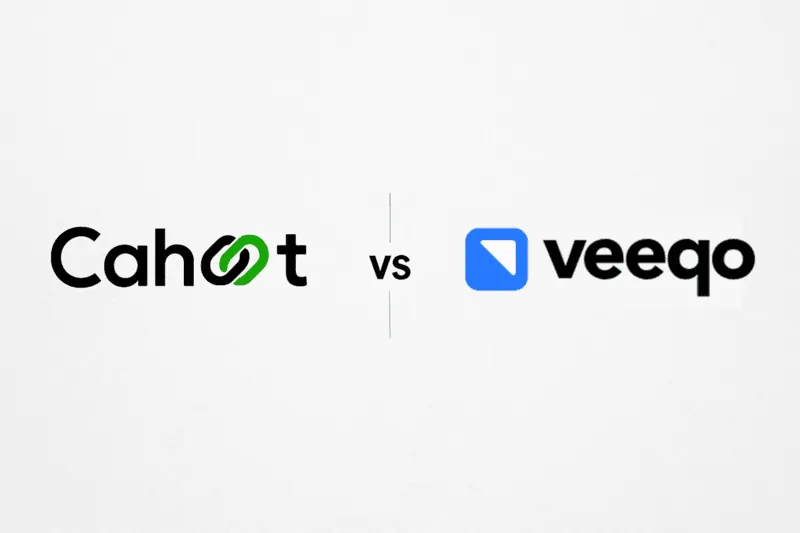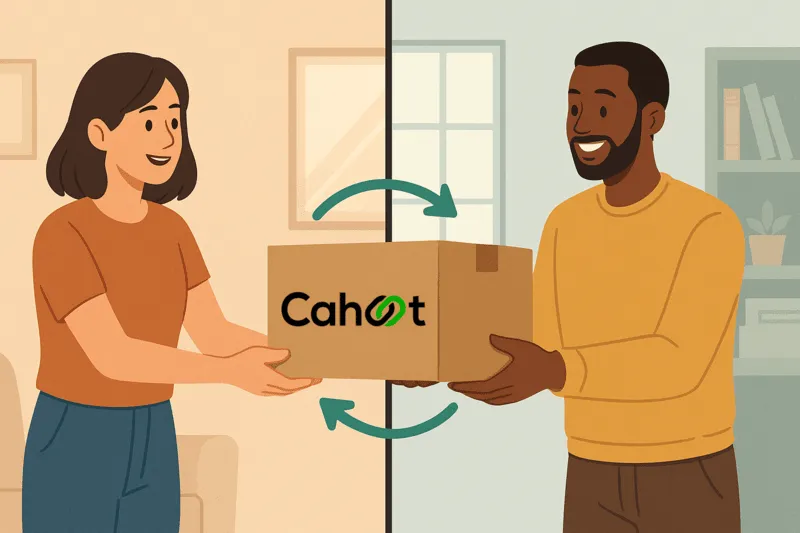Walmart 3PL Success: Why Most 3PLs Don’t Support Walmart Properly (And How to Vet Them)
If you sell on Walmart Marketplace, your 3PL can make or break your growth. Selling on Walmart Marketplace gives you the opportunity to reach millions of customers, expanding your potential audience significantly. The platform is surging, the buyers are trained on fast delivery, and Walmart’s physical stores quietly turbocharge the last mile. Most third-party logistics providers still operate with an “Amazon-only” mindset. That’s why so many Walmart orders get stuck, misrated, or delayed.
Here’s the playbook I use to evaluate a Walmart 3PL, so you get the upside of Walmart Fulfillment Services, cost savings on shipping, and a better customer experience without surprise hidden fees.
Slash Your Fulfillment Costs by Up to 30%
Cut shipping expenses by 30% and boost profit with Cahoot's AI-optimized fulfillment services and modern tech —no overheads and no humans required!
I'm Interested in Saving Time and MoneyWalmart Marketplace Is A Different Animal
Walmart’s Marketplace isn’t a niche anymore. Seller count and volume have accelerated through 2025, with Marketplace Pulse tracking a 30 percent increase in sellers in the first five months alone and a rapid influx of international sellers. Translation, more competition, and a higher bar for fast delivery and customer expectations.
And Walmart keeps leaning into its superpower, stores. The company extended delivery coverage to 12 million more households in 2025 using geospatial routing, letting multiple Walmart stores fulfill a single order. That store network, rebranded as Accelerated Pickup and Delivery (APD), turns physical stores into fulfillment centers for real-time speed. Walmart fulfillment centers and warehouses are strategically located to enable fast delivery and efficient inventory management. These Walmart fulfillment centers and warehouses play a key role in storing products and supporting the fulfillment center network. Effective warehousing and storing inventory are essential for meeting Walmart’s delivery expectations and ensuring accurate, timely order fulfillment.
If your 3PL can’t plug into that ecosystem, or at least align to its service levels, your Walmart orders will lag.
Why Most 3PLs Miss The Mark On Walmart
1. They copy-paste Amazon SOPs. Routing rules, order management systems, and fulfillment process logic often assume Amazon’s cutoffs and zones. Walmart’s promise logic is different, and Walmart fulfillment windows require different carriers, shipping costs math, and cubic foot handling. If your 3PL doesn’t tune templates for Walmart, you eat hidden costs and miss same-day shipping promises. Understanding Walmart’s requirements is essential for 3PL success, as optimizing your supply chain and ensuring compliance are key to smooth operations. When evaluating a third-party logistics (3PL) provider, consider key factors like lead times, return processes, and pricing to ensure efficient order management and customer satisfaction. Choosing the right fulfillment partner can be a game-changer for Walmart sellers, enabling you to deliver products reliably and on time, and taking advantage of advanced 3PL services and technology can further optimize your operations.
2. They don’t model store-adjacent speed. Walmart’s network reduces zones for last-mile lanes. Your 3PL should steer Walmart Marketplace sellers toward regional carriers or local injection that mirrors APD pace, not default to national major carriers every time. Recent data shows Walmart customers leaned heavily into same-day during summer deal weeks, because stores are everywhere. When it comes to delivering orders quickly, fulfillment speed is critical; your 3PL must be capable of delivering orders quickly to meet customer expectations and ensure they are delivered accurately.
Looking for a New 3PL? Start with this Free RFP Template
Cut weeks off your selection process. Avoid pitfalls. Get the only 3PL RFP checklist built for ecommerce brands, absolutely free.
Get My Free 3PL RFP3. They skip WFS knowledge. Even if you don’t use Walmart Fulfillment Services (WFS), your 3PL should know the program’s fulfillment fees, storage rules, hazmat items policies, and routing guide, because those benchmarks anchor buyer expectations, and they’re often cheaper than you think. As of April–July 2025, Walmart publicized that WFS averages about 15 percent less than “the competition” with clear storage/optional fee tables and peak windows. Testing shipments with your 3PL before full rollout is important for quality and compliance, and helps ensure smooth scaling of your operations.
4. They don’t support Walmart-specific data flows. You need real-time tracking in Seller Center, clean inbound receiving for fulfillment centers, and order processing events that match Walmart’s performance scorecards. A 3PL that can’t expose these events reliably will ding your customer satisfaction and rank. It is also important to promptly mark orders as shipped once they are dispatched, maintaining transparency and trust with your customers.
5. They hide fees. Watch for “Walmart handling” surcharges, unexpected packaging materials fees, and shipping weight upcharges for large cube items. If you can’t audit fulfillment fees per order, you can’t scale. For large or bulk items, having freight options is essential to ensure efficient and cost-effective shipping.
The 12-Point Walmart 3pl Vetting Checklist
1. Native Walmart integration, not a connector-of-a-connector. Test order create, cancel, ship confirm, returns, and real-time tracking.
2. Walmart promises parity. Can they meet WFS-like SLAs on 1 – 2 days to core zip clusters, and do they simulate Walmart’s promise windows before you publish offers?
3. Regional carrier bench. Ask for their on-time performance across Zones 5 – 8 for your top five lanes. If they only quote national carriers, expect higher shipping costs.
4. Store-adjacent injection. Do they support scheduled late pickups or local injection to mirror APD speed near key Walmart stores?
5. Dim and cube handling. Walmart’s heavy and oversize rules differ; ensure cartonization and cubic foot billing are transparent.
6. Peak season plan. Can they surge headcount and dock space for peak season without “capacity caps”? Get last Q4’s throughput.
7. Hazmat and temperature control. If you sell aerosols or meltables, confirm temperature control zones and hazmat credentialing.
8. Returns and reverse logistics. How fast can they receive, grade, and restock?
9. Value-added services. Kitting, relabels, packaging materials swaps, and order management exceptions.
10. Inventory management maturity. Cycle counting, shrink reporting, and slotting tuned for your top SKUs.
11. Transparent pricing. Line-item fulfillment services by pick, pack, dunnage, storage; no “Walmart” surcharge.
12. Case studies on Walmart. Ask for references from marketplace sellers with your weight and cube profile.
Scale Faster with the World’s First Peer-to-Peer Fulfillment Network
Tap into a nationwide network of high-performance partner warehouses — expand capacity, cut shipping costs, and reach customers 1–2 days faster.
Explore Fulfillment NetworkWhen To Mix WFS And A 3PL
WFS is compelling, especially for fast movers that fit the fee table. You still need a third-party logistics partner for multichannel work, oversized items, or SKUs that perform better outside WFS. WFS publishes current pricing, optional services, and routing guides. Use those to set target service levels for your 3PL.
A hybrid model works: let WFS carry your highest-velocity Walmart SKUs, and use a vetted Walmart 3PL for the long tail and multi-channel orders (Shopify, DTC, marketplaces). Walmart has also been investing in seller services and embedded finance to speed payouts, another reason volume is migrating. Your 3PL should be ready to ride that wave, not fight it.
Practical Takeaways
- Treat Walmart like Walmart, not Amazon. Different promise logic, different network, different fulfillment solutions.
- Build a carrier mix that prefers short zones and regional speed.
- Benchmark against WFS fees and SLAs, even if you don’t use them.
- Demand transparency on hidden costs and fulfillment operations.
- Use Walmart’s store network to your advantage; shorter delivery equals happier customers, higher sales, better rank.
Cahoot supports Walmart out of the box: multi-node routing, regional carriers, WFS-aware promise modeling, and transparent order fulfillment costs you can audit down to the SKU.
Frequently Asked Questions
What makes a Walmart 3PL different from an Amazon-only 3PL?
Walmart’s promise logic, store-adjacent fulfillment, and WFS benchmarks require different routing, carrier selection, and service windows. A Walmart-ready 3PL maps to APD coverage and WFS-like SLAs rather than cloning Amazon rules.
Should I use Walmart Fulfillment Services or a 3PL?
Use WFS for fast movers that fit the fee table. Pair a 3PL for oversized items, bundles, and multi-channel work. Many brands run both to balance cost savings, fast delivery, and control.
How fast is Walmart really growing in 2025?
Marketplace seller growth has accelerated through 2025, and Walmart reported strong ecommerce momentum into FY25. That means more competition and higher expectations on speed and price.
What hidden fees should I watch for in Walmart fulfillment?
Look for cartonization upcharges, “Walmart handling” adders, hazmat surcharges, peak storage, and mis-billed shipping weight on large cube items. Compare against WFS’s public rate card to catch anomalies.
How does Cahoot help Walmart Marketplace sellers?
We tune routing to Walmart’s speed map, leverage regional carriers to shorten zones, expose granular cost lines, and support hybrid WFS + 3PL strategies so you can fulfill orders faster, at lower total cost.

Turn Returns Into New Revenue
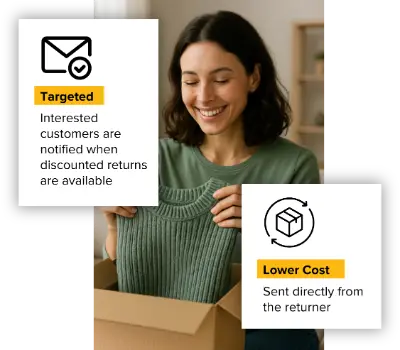
“Trade Enforcement” Crackdown: New Rules that Could Kill Your Ecommerce Business
In this article
 11 minutes
11 minutes
- Why The Pressure Is Rising (And Why Ecommerce Feels It First)
- The Five Most Common Potholes I See In 2025 (And How They Escalate)
- What Actually Happens When You’re Flagged (Beyond The Fine Print)
- DDP: Keep It, Fix It, Or Sunset It?
- The Practical Compliance Stack (What High-Performing Merchants Are Already Doing)
- The Omnichannel Wrinkle Most Teams Miss
- Logistics Strategy As A Compliance Strategy
- A 30-Day Sprint To De-Risk (Without Pausing Growth)
- The Mindset Shift That Separates Survivors From Strugglers
- Frequently Asked Questions
Trade rules used to be a background task. In 2025, they’re a front-of-house risk. Customs is asking harder questions. Penalties are steeper. And the playbook that worked when duties were low and parcel flows were lightly scrutinized? That playbook is retired.
I’m speaking as a logistics operator who works with ecommerce brands every day. The short version: enforcement is up, tolerance for “close enough” is down, and the burden of proof sits squarely with importers and their vendors. Let’s review how tariff policy, country-of-origin rules, DDP flows, and forced-labor screening converge, and what smart teams are doing now to reduce risk without slowing growth.
Why The Pressure Is Rising (And Why Ecommerce Feels It First)
Multiple forces are pushing enforcement to the top of the agenda this year:
- Tariff exposure is higher. Broader and/or higher duties increase the incentive to under-value or misclassify, and regulators respond by tightening audits, detentions, and penalties.
- Country-of-origin (COO) is decisive. Origin dictates duty rate and eligibility under trade programs. Transshipment and “last-touch” assembly to disguise origin are specific enforcement targets.
- De minimis scrutiny is real. Small parcels are no longer invisible; regulators are watching for patterns that look like duty avoidance through under-valuation or routing.
- Forced-labor rules (e.g., UFLPA) bite. If CBP suspects a link to forced labor in the supply chain, they can detain shipments until you prove otherwise. For seasonal brands, a multi-week detention can be fatal to margin and cash flow.
- Data analytics at the border. Customs systems flag anomalies: repeated “just under” values, implausible tariff codes for the product type, and IORs with inconsistent histories.
For ecommerce, the pain shows up faster: detention of a few containers, a batch of small parcels flagged, or a post-entry demand for duties/penalties can erase a quarter’s profit. Even if you clear it up, the operational whiplash (stockouts, customer delays, returns surge) lingers.
Slash Your Fulfillment Costs by Up to 30%
Cut shipping expenses by 30% and boost profit with Cahoot's AI-optimized fulfillment services and modern tech —no overheads and no humans required!
I'm Interested in Saving Time and MoneyThe Five Most Common Potholes I See In 2025 (And How They Escalate)
1) Misclassification (the wrong HTS code)
It often starts innocently, copying a competitor’s code, reusing a legacy code, or “choosing the lower rate” when two codes seem plausible. When the rate delta is large, auditors assume motive.
How it escalates: Repeated misclassification can trigger penalties, prior-entry reviews, or a full audit. In worst cases, it becomes a False Claims Act issue (government alleging underpayment of duties over time).
What to do instead: Build a defensible classification file for each SKU: product specs, composition, function, classification logic, and ruling references. Require supplier spec sheets. Re-review codes when products change materials or features.
2) Undervaluation (declaring less than the true transaction value)
Under pressure, some suppliers propose “commercial” and “customs” invoices with different values, or omit “assists” (molds, artwork, free components you provide) from valuation.
How it escalates: If discovered, CBP (Customs and Border Protection) can assess duties on the real value plus penalties and interest. Repeat issues risk referral to the DOJ or civil False Claims Act (FCA) action. Banks and marketplaces also get spooked by headline violations.
What to do instead: Document the full consideration paid for the goods and include assists where applicable. Align finance, procurement, and logistics so the customs value precisely matches your books.
3) Country-of-origin errors (and transshipment)
Relabeling or “light assembly” in a third country doesn’t necessarily change origin. If the COO is wrong, the duty rate and program eligibility are wrong.
How it escalates: CBP can detain, demand proof of substantial transformation, and assess back duties. If they see intent, penalties rise.
What to do instead: Map your product’s transformation steps. Keep supplier affidavits and manufacturing records. When in doubt, ask a broker or attorney for a written origin determination.
4) DDP flows with opaque importers of record
Delivered Duty Paid (DDP) makes for a frictionless customer experience, but introduces blind spots. If a logistics intermediary is the Importer of Record (IOR) for many small parcels, you need to know exactly how they declare value, classification, and origin.
How it escalates: If the IOR under-declares or uses suspect codes, your parcels get detained or returned. Even if the IOR is legally liable, your brand takes the hit with customers and marketplaces.
What to do instead: Demand transparency from any DDP partner: who is IOR, what values/codes are used, and how compliance is monitored. Consider shifting to bulk import as your IOR (pay duties cleanly once), then fulfill domestically for speed and predictability.
5) Forced-labor concerns (UFLPA and beyond)
If any component is suspected of being made with forced labor, CBP can detain it. The hard part: the presumption flips, you must prove your goods are clean.
How it escalates: Weeks of detention, missed sales windows, and, in some cases, denial of entry. Apparel, textiles, electronics accessories, and categories with cotton or polysilicon content are frequent targets.
What to do instead: Collect supplier attestations and traceability data down to raw materials where feasible. Maintain a dossier you can furnish quickly if asked (bills of materials, chain of custody, and audit summaries).
What Actually Happens When You’re Flagged (Beyond The Fine Print)
Let’s demystify the play-by-play:
- Administrative delay: CBP requests information or issues a detention notice. Meanwhile, inventory is stuck.
- Clock starts: You provide documents within a short window. If you scramble for proof, your ops team scrambles too.
- CBP decision: Release, rework, re-export, or seizure, plus potential duty adjustments.
- After-action: Even if released, your IOR is put on a watch list; future entries see more scrutiny.
- Financial echo: Freight sits longer (demurrage/detention), promotions slip, cancellations rise. Your returns team gets slammed weeks later.
The tangible cost is bigger than the duty bill: missed velocity, customer trust, and internal time. That’s why prevention wins the ROI contest every time.
Looking for a New 3PL? Start with this Free RFP Template
Cut weeks off your selection process. Avoid pitfalls. Get the only 3PL RFP checklist built for ecommerce brands, absolutely free.
Get My Free 3PL RFPDDP: Keep It, Fix It, Or Sunset It?
DDP shines for CX: no surprise charges, faster door-to-door. The problem isn’t DDP itself; it’s opaque DDP. If you can’t audit the IOR’s declarations, you’re borrowing risk at high interest.
Decision framework:
- Keep DDP if you can fully audit values, codes, and COO, and your categories are low-risk.
- Fix DDP by moving IOR to your entity (or a transparent partner), with your codes and values, and pre-agreed documentation standards.
- Sunset DDP for high-risk lines and import in bulk to U.S. facilities you control; ship domestically for reliability.
A lot of brands are landing on a hybrid: DDP for low-risk SKUs and bulk import for everything seasonal or compliance-sensitive.
The Practical Compliance Stack (What High-Performing Merchants Are Already Doing)
Think of this as your operating system for 2025. It’s not glamorous, but it’s how you keep selling when others get sidelined.
1) Governance: make someone the owner
Assign a trade compliance owner, often in ops or finance, with authority to set policy and say “no” when shortcuts are proposed. Publish a one-page policy: classification rules, valuation requirements (including assists), COO standards, and who can approve exceptions.
2) Product data discipline
Create (and maintain) a spec file for each SKU: materials, function, key dimensions, use case. Tie that to your HTS justification, COO evidence, and any rulings or broker memos. When product changes, the spec and code get reviewed. No exceptions.
3) Broker and partner alignment
Choose brokers who explain their reasoning and document it. Ask your freight forwarders and parcel partners how they monitor compliance. If anyone suggests “we can lower your duty with a different code,” you’ve found a weak link.
4) Documentation muscle
Keep clean records for five years: invoices, packing lists, purchase orders, payment proofs, supplier declarations, bills of lading, and correspondence. For UFLPA-sensitive goods, maintain traceability artifacts up front instead of chasing them later.
5) Internal controls and audit rhythm
Implement a pre-filing review on risky entries (new SKUs, new suppliers, tariff-sensitive lines). Run a quarterly mini-audit: sample 20 – 50 entries, verify codes/values/COO, and fix upstream root causes. Audit findings go to leadership, not to shame, but to fund fixes.
6) Sourcing strategy that respects reality
If duty rates spike on a core line, don’t just tweak codes; re-evaluate sourcing. Consider nearshoring or alternate suppliers with a cleaner COO and better documentation habits. Build that analysis into your gross margin planning, not as a last-minute emergency.
7) Plan for the worst (because it’s cheaper than the worst)
Draft a detention playbook: who compiles documents, what proof you provide for value/COO, what you’ll concede quickly to get goods released, and when you escalate to counsel. When hours matter, the team needs a script.
8) When to call a lawyer (and when to self-disclose)
If you discover past underpayments or suspect a systemic error, consider a voluntary disclosure through counsel. Penalties can be substantially reduced when you come forward first. This is not a sign of weakness; it’s how sophisticated companies fix problems before they become catastrophes.
The Omnichannel Wrinkle Most Teams Miss
Marketplace rules are converging with trade enforcement. Some platforms increasingly require accurate COO disclosure and will suspend listings that appear non-compliant. Meanwhile, retailers (B2B) push import reps and origin attestations into vendor standards. Translation: your sales channels are becoming compliance checkpoints. If you centralize product truth (specs, codes, COO, compliance docs), you’ll satisfy both customs and channels, and you’ll do it once.
Logistics Strategy As A Compliance Strategy
How you fulfill orders can raise or lower risk:
- Bulk import + domestic fulfillment reduces customs touchpoints and concentrates documentation into fewer entries you can control and defend. It also stabilizes lead times and avoids consumer-facing customs delays.
- Distributed inventory (multiple U.S. nodes) shortens zones and speeds delivery, but requires tighter inventory control and returns routing. Make sure your WMS/3PL can track lots/serials if you need that for audits.
- Returns processing should include basic QC and disposition rules. If you re-export returns or do cross-border returns, align those flows with customs filings to avoid mismatches.
Light Cahoot note: in our network work, we see brands move from risky DDP to bulk import with domestic 1 – 2 day coverage. It’s not just a shipping speed upgrade; it’s a compliance posture upgrade. You consolidate exposure, standardize documentation, and get predictable operations for peak.
Scale Faster with the World’s First Peer-to-Peer Fulfillment Network
Tap into a nationwide network of high-performance partner warehouses — expand capacity, cut shipping costs, and reach customers 1–2 days faster.
Explore Fulfillment NetworkA 30-Day Sprint To De-Risk (Without Pausing Growth)
You don’t need a six-month overhaul to be safer by next month. Here’s a pragmatic sprint:
Week 1: Map the risk
- List the top 50 SKUs by revenue. Confirm codes, COO, and values.
- Flag sensitive materials (cotton, polysilicon) and high-duty categories.
- Identify DDP lanes and who is the IOR.
Week 2: Fix the easy stuff
- Correct obvious misclassifications; document logic.
- Update invoices to include assists where missing.
- Get supplier origin attestations for flagged SKUs.
Week 3: Partner alignment
- Brief your broker and forwarder on your policy; ask for their ideas.
- If DDP is opaque, demand transparency or begin shifting those SKUs to bulk import.
Week 4: Institutionalize
- Publish your one-pager compliance policy and assign an owner.
- Schedule the quarterly mini-audit and a tabletop “detention drill.”
- Add compliance checkpoints to your new product introduction (NPI) process.
You’ll come out with cleaner data, aligned partners, and a plan if a shipment gets flagged. That’s real insurance you can feel.
The Mindset Shift That Separates Survivors From Strugglers
The winners don’t treat customs as a form to fill; they treat it as an operating capability. They build product truth, choose partners who document, and rehearse the bad days so they aren’t bad for long. They also use trade reality to make better business calls, where to source, what to price, and which SKUs deserve expansion.
And they don’t wait for a notice of action to get with the program. They act now because the cheapest time to fix compliance is before anyone asks.
Frequently Asked Questions
What is driving the increase in trade enforcement in 2025?
Rising geopolitical tensions, tariff disputes, and renewed focus on supply chain transparency have prompted regulators to increase enforcement actions. Agencies are targeting misclassification, false country-of-origin labeling, and duty evasion more aggressively.
Which violations are ecommerce sellers most at risk for?
Common pitfalls include incorrect HTS codes, undervaluing shipments to avoid duties, failing to update country-of-origin information, and ignoring new tariff requirements. Even small oversights can trigger fines or shipment seizures.
How can ecommerce brands reduce compliance risk?
Maintain accurate product data, regularly review tariff classifications, and ensure all suppliers follow current labeling and documentation requirements. Investing in compliance audits and training can help prevent costly mistakes.
What happens if a shipment is found non-compliant?
Consequences range from delayed deliveries and financial penalties to the loss of import privileges. In severe cases, businesses can face reputational damage and long-term operational disruptions.
How does Cahoot help sellers stay compliant?
While Cahoot does not act as a customs broker, its fulfillment network and technology are built to support sellers’ compliance needs, including accurate order data, transparent shipping documentation, and partnerships with trusted logistics providers. Our network of freight forwarders are all experts and can consult with sellers one-on-one to clarify any questions they may have.

Turn Returns Into New Revenue

Flexport’s $5,000 Monthly Minimum: What It Really Means and How to Respond
In this article
 6 minutes
6 minutes
- What Changed (And Why Timing Matters)
- Who’s Most Affected
- Why Flexport Would Make This Move (The Business Logic)
- The Part Nobody Says Out Loud: Indecision Is The Most Expensive Option
- How To Decide: A Quick Financial Model That Actually Helps
- What To Look For In A Modern Fulfillment Partner (A Practical Checklist)
- Migration Without The Mayhem (A Realistic 30/60/90)
- The Bigger Strategic Takeaway
- Bottom Line
- Frequently Asked Questions
Flexport’s shock move to a $5,000 monthly minimum fee has me, and a lot of ecommerce folks, doing double takes. When a fulfillment partner suddenly wants five grand a month just to play ball, you know something big is up. Is it a cash grab, a pivot to enterprise clients, or a bit of both? All I know is it’s making small and mid-sized sellers very nervous, right on the cusp of peak season. Let’s connect the dots on why the change is happening, who’s affected, and how to make a smart, low-risk pivot if it’s time to move.
What Changed (And Why Timing Matters)
Flexport previously introduced a lower monthly minimum ($500 that went into effect in July 2025); now the new floor is $5,000 per month starting in 2026. The practical effect: if total eligible fulfillment charges don’t hit $5K in a given month, the account pays the difference. For high-volume programs, this is noise. For long-tail or seasonal brands, it’s a budget line item that can overshadow margins, particularly in shoulder months before and after peak.
The timing matters. Q4 is when nobody wants to switch warehouses, yet Q1 is when many realize they can’t carry a $5K retainer through softer months. The risk isn’t just cost, it’s opportunity cost: funds tied up in minimums aren’t available for ad spend, inventory buys, or conversion optimization that actually drives growth.
Slash Your Fulfillment Costs by Up to 30%
Cut shipping expenses by 30% and boost profit with Cahoot's AI-optimized fulfillment services and modern tech —no overheads and no humans required!
I'm Interested in Saving Time and MoneyWho’s Most Affected
This policy naturally favors enterprise and upper mid-market sellers with steady, diversified volume. Brands below that line face three predictable issues:
- Spend variability. Even healthy DTC brands can dip below thresholds off-peak. Paying to “top up” an invoice for unused capacity is hard to justify.
- Single-channel exposure. If most orders ride one channel (e.g., pure DTC), any seasonal dip increases the odds of missing the minimum.
- Complexity premiums. Niche products (oversize, hazmat, kitting) can already carry handling premiums; layering a high monthly minimum increases effective cost per order further.
In short: if your monthly spend frequently sits under $5K, the policy isn’t just a price, it’s a filter. Flexport is concentrating resources on larger programs that keep buildings and teams fully utilized.
Why Flexport Would Make This Move (The Business Logic)
Running a national fulfillment network is capital-intensive. Labor volatility, real estate costs, inventory carrying friction, and parcel rate dynamics put pressure on contribution margins. High minimums guarantee a revenue floor, simplify capacity planning, and prioritize “dense” accounts with smoother demand curves. There’s also a quality-of-service argument: fewer small accounts can mean more focus per large account, which can raise service consistency metrics that enterprises care about.
Zooming out, this aligns with a broader industry trend: many logistics providers are rationalizing their account portfolios, fewer logos, deeper relationships, tighter SLAs, better unit economics. It’s not inherently anti-small-business; it’s a statement about fit.
The Part Nobody Says Out Loud: Indecision Is The Most Expensive Option
Brands often wait until fees hit the P&L to explore alternatives. That delay compresses transition timelines and raises migration risk during high-velocity periods. A better approach is a two-lane plan:
- Lane A: Renegotiate or right-size with your current provider (if your growth path will soon exceed $5K consistently).
- Lane B: Stage a low-risk migration path now (parallel onboarding, dark launch, and ramp) so you’re not forced into a rushed move when an invoice surprises you.
Treat this as optionality engineering. You’re buying a real option to change providers without disrupting peak.
Looking for a New 3PL? Start with this Free RFP Template
Cut weeks off your selection process. Avoid pitfalls. Get the only 3PL RFP checklist built for ecommerce brands, absolutely free.
Get My Free 3PL RFPHow To Decide: A Quick Financial Model That Actually Helps
Skip generic “compare pick/pack fees” spreadsheets. Build a simple model around the effective cost per shipped order across months:
- Inputs: projected monthly order count, average lines per order, weight/zone mix, storage needs, returns rate, value-added services (kitting, FBA prep, labeling), and expected surge weeks.
- Add provider terms: minimums (if any), onboarding fees, per-SKU fees, project work, storage tiers, and long-term storage thresholds.
- Output: blended cost per order by month, then a rolling 12-month view.
If the curve spikes in low months because of a high minimum, you have a structural mismatch. If a prospective partner shows a smoother curve, even if some unit rates are higher, that stability is often worth more than chasing the lowest headline fee.
What To Look For In A Modern Fulfillment Partner (A Practical Checklist)
Use this as your RFP backbone and internal scorecard:
- Network fit: Facilities where your customers are. Can they reach 95%+ of orders in 2 days with sane parcel spend?
- Peak playbook: Documented surge staffing, cutoffs, capacity reservations, blackout dates, and comms cadence. Ask for their last peak postmortem.
- Omnichannel readiness: Shopify/Commerce (Formerly BigCommerce) + marketplaces (Amazon, Walmart, Target, TikTok Shop), retail EDI, wholesale/B2B, and basic FBA prep capability.
- Returns & exchanges: Prepaid flows, disposition rules, refurbishment, grading photos, automated refunds/credit rules.
- SLA clarity: Receiving, pick/pack cutoffs, same-day rate, weekend ops, accuracy guarantees, and what credits actually apply if they miss.
- Billing transparency: Line-item detail and self-serve reporting so finance isn’t decoding mystery charges at month’s end.
- Data & visibility: Order status, inventory aging, serial/lot support, backorder handling, and webhooks for your downstream systems.
- Integration effort: Native connectors and implementation timeline. Weeks, not months, is realistic for most DTC stacks if the provider is organized.
- Change management: Dedicated onboarding PM, sample test plan, SKU audit, packaging standards, and go-live rollback plan.
- Cultural fit: How they escalate issues, how often they proactively communicate, and whether leadership shows up when it counts.
Light Cahoot note: Cahoot operates a collaborative network model focused on fast, affordable DTC fulfillment and omnichannel support. Sellers we work with often care most about nationwide 2-day coverage, reliable peak performance, transparent billing, and a straightforward and quick onboarding path. If you’re evaluating options, those are useful criteria, regardless of which partner you pick.
Scale Faster with the World’s First Peer-to-Peer Fulfillment Network
Tap into a nationwide network of high-performance partner warehouses — expand capacity, cut shipping costs, and reach customers 1–2 days faster.
Explore Fulfillment NetworkMigration Without The Mayhem (A Realistic 30/60/90)
Days 0–30: Plan
- Freeze the SKU list (rationalize variants, confirm barcodes, set carton & case specs).
- Export the order/inventory history you need for demand planning and slotting.
- Lock packaging standards (mailers vs. cartons, dunnage, sustainability requirements).
- Schedule sandbox connections and a sample order test plan.
Days 31–60: Parallelize
- Ship seed inventory to 1–2 nodes; run dark orders (live picks that don’t ship) to test SLAs and WMS events.
- Turn on 5–10% of live traffic for a clearly labeled subset (e.g., West Coast orders <3 lbs).
- Run daily scorecards: receiving time, pick accuracy, scan compliance, carrier performance, support responsiveness.
Days 61–90: Ramp
- Shift 50–80% of traffic. Keep some volume with the legacy provider as a safety valve through the first cycle of returns.
- Migrate remaining nodes/regions.
- Conduct a post-go-live review and lock Q4 surge capacity in writing (dates, volumes, incentives).
This staggered approach lowers risk and gives you real performance data before you bet the brand on a new setup.
The Bigger Strategic Takeaway
Flexport’s $5,000 minimum isn’t an indictment of small brands; it’s a portfolio strategy decision. For many sellers, it’s the nudge to step back and ask: Is my fulfillment model aligned with how my business actually grows? If you’re subsidizing unused capacity to hit a line on an invoice, it’s a mismatch. If you’re locked into a footprint that doesn’t match your demand map, it’s a mismatch. You get the idea.
Use this moment to build a fulfillment stack that earns its keep every month, transparent, resilient, scalable, and tied to outcomes you can measure: faster delivery, higher conversion, lower WISMO, fewer cancellations, better post-purchase NPS, and cleaner financials. If Flexport’s new structure fits that vision for you, great. If not, now you’ve got a plan to move, thoughtfully, not frantically.
Bottom Line
This policy sets a high bar. Some brands clear it; many won’t. What matters is not reacting with frustration but responding with structure: model the costs honestly, pressure-test alternatives, and stage a migration path that protects Q4 while setting you up for a steadier 2026. The logistics market is big. There’s room to find the right fit, and to make fulfillment a strategic advantage, not a fixed cost you have to explain every month.
Frequently Asked Questions
Why did Flexport raise its monthly minimum fee to $5,000?
Flexport has not publicly detailed the exact reasoning, but industry watchers speculate the move aligns with a strategic shift toward larger, higher-volume clients that can meet the new threshold consistently. It may also be aimed at improving profitability and operational efficiency as fulfillment costs rise.
Who will be most affected by the $5,000 minimum fee?
Small and mid-sized ecommerce brands that don’t generate enough volume to justify the new fee will feel the most impact. Many of these sellers will now explore alternative fulfillment solutions ahead of peak season to avoid margin erosion.
What should sellers consider before switching from Flexport?
Evaluate potential fulfillment partners on cost structure, geographic network coverage, service level agreements, technology integrations, and scalability. Sellers should also consider the provider’s track record with on-time delivery, returns handling, and peak season performance.
Could this signal a trend among other fulfillment providers?
While most providers have not announced such steep minimum fee hikes, the move could prompt competitors to reevaluate pricing models, especially if labor, real estate, and transportation costs continue to climb.
Can Cahoot help sellers affected by Flexport’s new policy?
Cahoot works with brands of all sizes to create flexible, cost-efficient fulfillment strategies. While every seller’s needs differ, Cahoot’s distributed network model often provides competitive alternatives for those no longer a fit for Flexport’s pricing.

Turn Returns Into New Revenue

How to Manage USPS Peak Season 2025 Rate Hikes and Protect Margins
In this article
 10 minutes
10 minutes
Brace yourselves, USPS is doing it again with a holiday “temporary” rate hike for shipping. As an ecommerce operator, you’ve probably learned to bake these annual USPS surcharges into your peak season planning (even if they still sting). For USPS Peak Season 2025, the Postal Service will levy extra charges on most package shipping services from October 5, 2025 through January 18, 2026 (pending Postal Regulatory Commission approval). That means for the entirety of Q4 and the early January return season, you’ll be paying more for USPS Priority Mail, Priority Mail Express, USPS Ground Advantage, and Parcel Select packages. How much more? On average, about 4% – 6% more per package, according to USPS, roughly a 5.1% surcharge on Ground Advantage and 4.1% on Priority Mail shipments. In practice, the surcharges are flat dollar amounts by weight and zone. A lightweight local package might only cost an extra $0.30 to $0.40 (for commercial vs. retail customers), but a heavier box going cross-country could see around a $6 – $7 hike. And if you’re shipping big stuff via Priority Mail Express, brace for up to a $16 increase on the heaviest long-distance parcels. In short, every domestic parcel shipped with the Postal Service during the holidays will cost more, with the exact pain determined by package weight and distance.
USPS isn’t doing this just for fun; they have their reasons (even if we don’t love it). The Postal Service says the temporary price change is needed to cover extra handling costs and to keep its rates in line with private competitors during the holiday surge. Essentially, UPS and FedEx slap peak surcharges on shippers each year, and USPS doesn’t want to leave money on the table. In the USPS press release, they explicitly stated that this peak pricing aligns with “competitive practices” and is part of their Delivering for America plan to restore financial stability. And boy, does USPS need the money; they reported a $3.1 billion loss in the quarter leading up to this announcement. Rising costs and lower mail volumes have put them deep in the red, so hiking package rates is one way to claw back revenue. It’s worth noting that these holiday surcharges have become a yearly tradition since 2020 (with a brief pause in 2023). Even though USPS calls them “temporary,” often some of that increase sticks around or gets baked into the next general rate increase. As a longtime fulfillment provider, I’ve seen those postage costs ratchet up year after year. So while USPS wants a successful peak season operationally, they also want to make sure we shippers are sharing the burden of all those extra trucks, overtime hours, and elf hats (okay, maybe not the hats) that come with the holidays.
Slash Your Fulfillment Costs by Up to 30%
Cut shipping expenses by 30% and boost profit with Cahoot's AI-optimized fulfillment services and modern tech —no overheads and no humans required!
I'm Interested in Saving Time and MoneyImpact on Ecommerce Sellers and Shippers
So, what does this mean for those of us sending out tons of packages during the holidays? In a nutshell: higher shipping costs and tighter margins. If you offer “free shipping” to customers, these surcharges eat directly into your profit per order. For example, if you normally spend $8 to ship a medium parcel and now it’s $9, that dollar is coming out of your bottom line unless you adjust prices. For merchants who charge customers for shipping, there’s a decision to make: do you raise your rates at checkout to pass on these extra fees? You might have to, especially on heavy items where an extra $5 – $7 is non-trivial. The challenge is doing so without scaring off potential customers. Holiday shoppers are price-sensitive, and a sudden jump in shipping costs could lead to cart abandonment. It’s a delicate balance.
Marketplace sellers face an extra wrinkle: platforms like eBay and Etsy charge their commission (final value fee) on the total transaction, including shipping. That means whenever USPS raises shipping rates, marketplaces get an automatic fee boost from your higher shipping charge. Ouch. It’s like a tax on top of a tax. For eBay sales, I know that a $0.50 postage increase might only marginally affect buyers, but it will also slightly increase the fee eBay takes. Multiply that across hundreds of orders, and it adds up. Postal Service surcharges can also influence shipping strategy. Some sellers might shift more volume to UPS or FedEx if those carriers turn out cheaper for certain weights, though keep in mind UPS and FedEx have their own peak surcharges (often targeted at large volume shippers or oversized packages) rather than a blanket increase on all parcels. So definitely compare rates on a case-by-case basis. Sometimes USPS will still be the most cost-effective even with the surcharge, especially for light packages and/or short distances. But for heavy boxes or Zone 8 shipments, UPS Ground might beat USPS Ground Advantage this year, depending on negotiated rates.
One often overlooked impact: package weight and dimensions optimization. With these flat surcharges kicking in at weight breakpoints, it’s a good reminder to optimize packaging. If you can reduce a package’s weight below 11 lbs (where a big jump occurs) or keep it in a lower zone by shipping from a closer warehouse, you should. For instance, the surcharge for a Ground Advantage package 0 – 3 lbs going far (Zones 5 – 9) is $0.50, but 4 – 10 lbs is $1.00. That’s double. If you can shave a pound or two off through smarter packing or split shipments by region to use nearer fulfillment centers, you can save that $0.50 per package. Over thousands of orders, it matters. This is where having a fulfillment partner like Cahoot with a nationwide network helps; you can forward-position inventory so that most customers are in Zones 1 – 4, where surcharges are much lower (e.g., $0.40 instead of $0.90 for a small parcel). It’s a strategy of “ship shorter distances” to mitigate costs. And you can quickly scale outsourced fulfillment up or down to match your real-time demand.
Looking for a New 3PL? Start with this Free RFP Template
Cut weeks off your selection process. Avoid pitfalls. Get the only 3PL RFP checklist built for ecommerce brands, absolutely free.
Get My Free 3PL RFPStrategies to Mitigate the Surcharge Surge
We can’t avoid the USPS hikes, but we can get creative to lessen the impact. Here are a few tactics either we (Cahoot) or our clients are using and recommending this peak season:
- Plan Pricing and Promotions Thoughtfully: Knowing shipping will cost more, consider adjusting your pricing or promo strategy. This might mean raising product prices a tad or setting a higher free shipping threshold to cover the difference. Alternatively, you could run a holiday sale on items but make it conditional on buying two or more units, that way you get more revenue per shipment (and effectively dilute the shipping cost per item).
- Use Multiple Carriers: Rate-shop every order through your shipping software. If UPS or FedEx can deliver a package cheaper (accounting for their surcharges too), use them. USPS is often best for small parcels, but as weight increases, the calculus can change. Having all three major carriers enabled offers flexibility. And don’t forget regional carriers; they sometimes don’t add surcharges or have lower base rates for nearby zones.
- Optimize Packing: This is a great time to review packaging. Can you use a smaller box or poly mailer to reduce dimensional weight? Can you remove unnecessary packing weight (without compromising product safety)? Even a few ounces off might keep you in a lower weight tier for the surcharge. Also, if you sell bundles, see if splitting into two lighter shipments (to avoid a heavy surcharge band) makes sense cost-wise, or vice versa, combining items to ship fewer packages.
- Leverage Fulfillment Centers in Strategic Locations: As mentioned, if you have the capability to ship from multiple warehouses, do it. The shorter the distance a package travels, the lower the zone and usually the lower the surcharge. My company Cahoot, for instance, places inventory in different regions, so an order to California ships from our West Coast node, arriving faster and incurring, say, a Zone 2 or 3 surcharge (just cents) instead of Zone 8 ($$$). If you’re FBA-only, you can’t control from which warehouse Amazon ships each order, but for your own site orders or Seller Fulfilled Prime, consider a fulfillment partner or 3PL network to distribute inventory.
- Communicate with Customers: This might not reduce costs, but it can preserve trust. If you do have to increase shipping fees or product prices due to carrier rates, be transparent. Customers remember how a company handles things during the crunch. A small note like “Due to seasonal USPS postage increases, our shipping rates will be slightly higher from Oct–Jan” can help manage expectations. Some sellers even encourage customers to order before a certain date to “beat the holiday shipping rush,” indirectly getting them to purchase early, before surcharges kick in on October 5.
Lastly, don’t forget that these surcharges will end (at least this round). Come mid-January, rates should revert to normal (or whatever the new normal is after any general increases). I always mark my calendar for the end date so I can monitor the new state of things. But I won’t be shocked if USPS announces that, say, certain “temporary” increases will roll into a permanent rate hike soon after. It’s happened before. The Postal Service knows that once we adjust to paying a bit more, we barely notice when it becomes the new baseline. Cynicism aside, the best approach is to adapt and control what we can. By optimizing our shipping processes and maybe tightening our belt elsewhere during peak, we can absorb this hit. After all, everyone is facing the same USPS surcharges, so in a way it’s a level playing field. If you manage them smarter than the next guy, that becomes a competitive advantage.
Bottom Line
The USPS peak season rate hike is a headache, but it’s not a show-stopper. As a shipper, treat it as a cost of doing holiday business and use it as motivation to streamline everything you can. And when you see those mail trucks hauling away your piles of Q4 orders, it’s okay to grumble a little about the extra fees, but then get back to work making sure your customers get their packages on time. Happy (expensive) holidays!
Scale Faster with the World’s First Peer-to-Peer Fulfillment Network
Tap into a nationwide network of high-performance partner warehouses — expand capacity, cut shipping costs, and reach customers 1–2 days faster.
Explore Fulfillment NetworkFrequently Asked Questions
When will the USPS peak season 2025 temporary price change take effect?
The Postal Service will apply temporary price changes from October 5, 2025, through January 18, 2026, pending Postal Regulatory Commission review, affecting multiple package shipping services.
Which USPS services are affected by the 2025 peak season rate hikes?
Priority Mail, Priority Mail Express, USPS Ground Advantage, and Parcel Select will all see surcharges, impacting commercial domestic competitive parcels and package services by weight and zone.
Why is the Postal Service raising rates for peak season 2025?
USPS says the temporary price change is needed to cover extra handling costs during high-volume periods and to keep rates in line with competitive practices used by other major carriers.
How much will USPS peak season 2025 surcharges cost shippers?
Surcharges range from around $0.30 for lightweight local USPS Ground Advantage parcels to as much as $16 for heavy Priority Mail Express shipments traveling long distances.
How can ecommerce sellers reduce the impact of USPS peak season rate hikes?
Sellers can optimize package weight, forward-position inventory to lower zones, use multiple carriers for package shipping services, and adjust pricing to cover extra handling costs while maintaining a successful peak season.

Turn Returns Into New Revenue

Tips for Combatting Higher Ground Shipping & Delivery Costs
Let me say it plainly: Ground shipping is no longer cheap. Not in 2025. The economy-tier services ecommerce brands relied on to keep costs down are rising faster than any other mode. And the kicker? You probably didn’t notice because they rose quietly. Just a few cents here, a new surcharge there. But it’s compounding…fast.
According to the latest TD Cowen/AFS Freight Index, economy ground parcel rates rose nearly 7.5% year-over-year in Q2 2025. That’s faster than air. Faster than LTL. And definitely faster than most brands can react.
Also, ground parcel rates hit 32% above the January 2018 baseline in Q2, an all-time high, even though average diesel prices fell. That tells you rate increases aren’t tied to fuel, they’re strategic margin plays.
Why is ground shipping getting more expensive?
FedEx and UPS aren’t running charities. In 2025, both carriers quietly inflated their accessorial fees, extended delivery-area surcharges (DAS), and repriced how they interpret “residential” addresses.
UPS, for example, now applies a Remote Area Surcharge to 15% more ZIP codes than in 2024. Combine that with the standard rate increases, and you’re looking at a 10–15% total effective increase for some DTC brands shipping to suburbs.
What’s driving it?
- FedEx’s network restructuring under its “Network 2.0” initiative
- UPS’s post-Teamsters contract cost recovery
- Fewer economy packages post-COVID peak = lower density = higher per-package costs
- Carriers are padding revenue per stop while demand softens
Slash Your Fulfillment Costs by Up to 30%
Cut shipping expenses by 30% and boost profit with Cahoot's AI-optimized fulfillment services and modern tech —no overheads and no humans required!
I'm Interested in Saving Time and MoneyThe Hidden Cost Curve: What the Data Tells Us
The logistics world has been quietly boiling, and most ecommerce operators don’t even realize how cooked they are until the Q4 freight invoices hit like a hammer. That’s why I wanted to step back and show what’s really going on with ground shipping costs, both over time and across weight and zone variables.
When you zoom out, the real story isn’t just one rate hike or another DAS update; it’s the slow, compounding weight of cost acceleration over time. That’s why we analyzed both the long-term parcel index trend and current 2025 rate tables from UPS and FedEx to show what’s happening beneath the surface.
Ground Parcel Index Trend (2018–2025): The Slow Burn That’s Now a Blaze
First, we charted the TD Cowen/AFS Ground Parcel Index from 2018 to 2025. This isn’t just any index; it’s an aggregated pulse check on ground parcel shipping costs across major carriers (UPS, FedEx, and USPS), normalized for inflation, fuel surcharges, and accessorial fees.
If you look at the trendline, you’ll see a gentle incline in the early years. Then 2020 hits. COVID disruptions + ecommerce boom = a sharp climb in rates. What’s surprising, though, is what happened next. You might expect some post-pandemic relief. Nope. The index kept climbing. By Q2 2025, it’s at its highest level ever, driven not by pandemic chaos, but by calculated carrier pricing strategies, DIM weight enforcement, and fewer carrier incentives for SMBs.
Takeaway: If you’re budgeting based on 2022 assumptions, you’re underwater. Index data shows that ground rates have structurally shifted up, and the new normal is…not normal at all. There’s a new silent tax on every ecommerce order, especially for brands that haven’t updated their logistics strategies in years.
Chart 1: FedEx and UPS Ground Parcel Index (2018–2025).
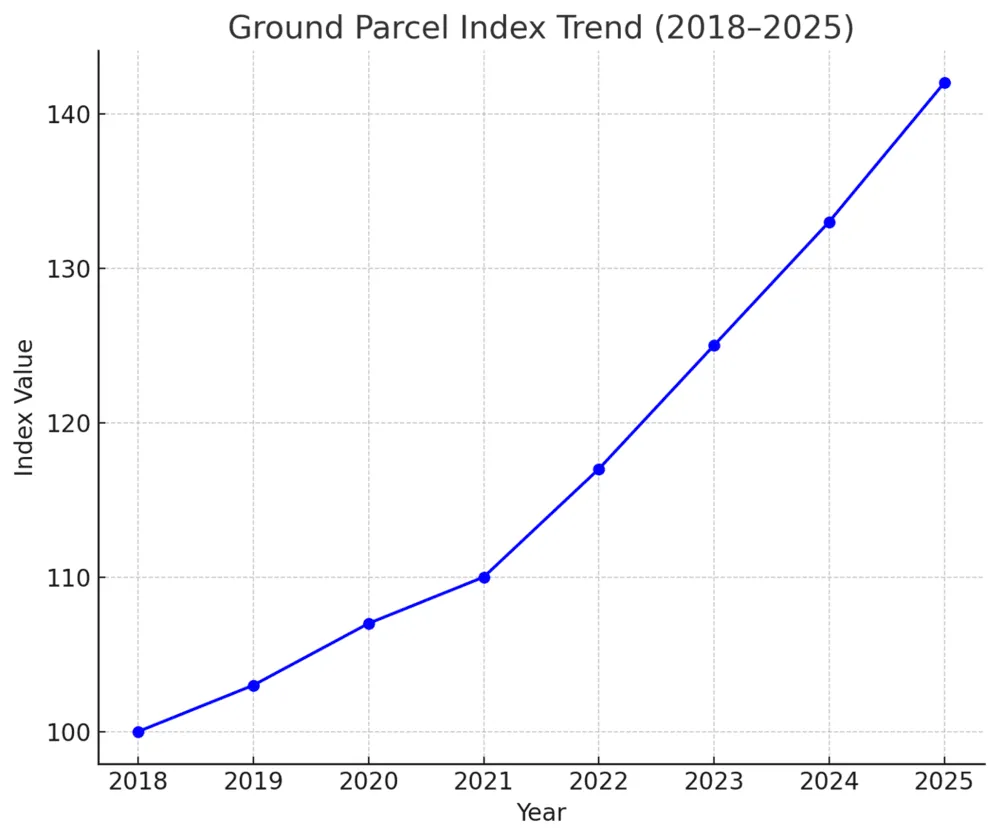
Billed Weight vs. Cost-Per-Package (Multi-Zone): The Hidden Geometry of Shipping Pain
The second chart shows the cost curve for shipping a package via ground, depending on billed weight and destination zone. This was derived by synthesizing rate tables from the official 2025 UPS and FedEx rate guides you can download right now. We simulated realistic pricing across Zones 2 through 8, for packages up to 50 lbs.
What becomes clear fast is this:
- Zone distance has a nonlinear impact. The same 10 lb box costs nearly 30–40% more to ship to Zone 8 than Zone 2.
- Weight-based costs aren’t flat. Each extra pound adds more than just weight; it multiplies cost, especially past the 10–15 lb range where rate brackets steepen.
- You’re probably getting crushed on midweight, long-zone shipments. That 18 lb box going to Zone 7 is silently eroding your margin every time you offer free shipping.
Takeaway: The average ecommerce merchant is overpaying because they’re not engineering for zone or weight efficiency. They’re just printing labels and hoping for the best. Big mistake.
Chart 2: Billed Weight vs. Cost-Per-Package by Zone (FedEx & UPS, 2025).
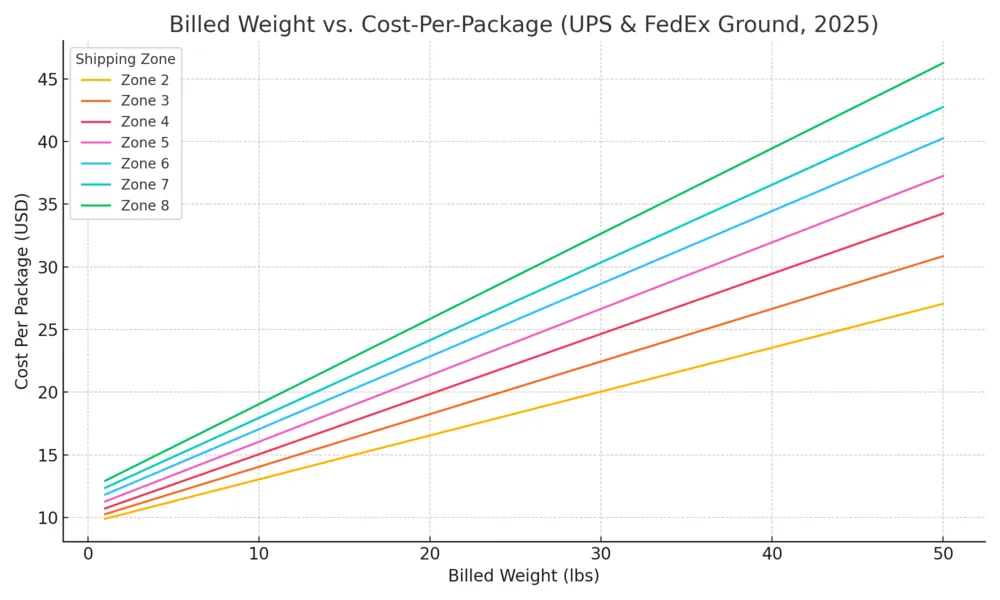
Key insights include:
- Zone escalation is brutal. The same 3 lb package can cost 2× as much going to Zone 8 versus Zone 2. A single-warehouse model is bleeding you dry on long-haul orders.
- Billed weight ≠ actual weight. Dimensional weight pricing inflates cost, especially when packaging isn’t optimized. A 2 lb item in a 12 × 12 × 10 box can be billed at 8+ lbs.
- Carrier policies diverge fast. USPS Ground Advantage offers strong pricing in Zones 2–5 for lightweight packages, while UPS’s negotiated discounts become more competitive at higher weights and volumes. FedEx Ground Economy still has a niche in deferred delivery, but fewer merchants rely on it due to limitations on delivery speed and flexibility (e.g., cannot deliver to PO Boxes).
- Flat rate isn’t always flat. Priority Mail Flat Rate boxes are convenient, but often more expensive than zone-based pricing for 2–5 lb packages going to Zones 2–4.
Takeaway: Don’t just look at average shipping cost. Build a dynamic model that accounts for zone distribution, dimensional weight risk, and carrier behavior. It sounds scarier than it really is: modern technology can help. For the rest of 2025 and into 2026, optimizing for billable weight and fulfillment geography isn’t a “nice-to-have.” It’s a survival strategy.
Looking for a New 3PL? Start with this Free RFP Template
Cut weeks off your selection process. Avoid pitfalls. Get the only 3PL RFP checklist built for ecommerce brands, absolutely free.
Get My Free 3PL RFPPractical Advice for Q3/Q4 2025 and Into 2026
So what’s the fix? Firstly, we’re seeing that brands are shifting lower-value, lightweight shipments to slower, economy service tiers, like FedEx Ground Economy or UPS Ground Saver, to soften cost spikes. But while slowing down your low-value shipments can help, it shouldn’t be the only lever you pull. You still have customer expectations to meet. Let’s dig into how you can keep up, fiercely and intelligently.
1. Shift Volume Strategically, Don’t Just Rant About Rates
The index shows that shippers are diverting lightweight parcels to slower service levels this quarter. That shift drove down cost per package but raised average billed weight, leading to surprising rate hikes in the index data.
Here’s what to test:
- Pilot deferred services for small items (under 2–3 lbs) and see if the slower ETA is worth the savings.
- Never just blanket shift—test geographically. Maybe shift East Coast to Ground Saver and keep West on Priority.
That data-backed nuance lets you stay lean without tanking delivery promises.
2. Audit Surcharges Like a Hunter, Because Carriers Are Hunting Yours
UPS raised its ground fuel surcharge by 15%, FedEx by 12%, even though diesel dropped by 8% YoY. That’s not cost pass-through, it’s revenue arbitrage.
And surcharges aren’t limited to fuel. UPS added fees for:
- Print services
- Payment processing
- Paper invoices
- Zone realignment errors
Every surprise fee is a profit leak if you don’t audit. Run monthly invoice audits using a service such as Refund Retriever or Cahoot’s Carrier Invoice Report to claw back charges and prevent reoccurrence. Benchmark your rates quarterly for visibility over time.
3. Optimize Packaging: Because Every Inch Costs
Don’t ignore the weight/zone multiplier. Carriers LOVE dimensional weight. As zones shift and surcharges rise, oversized packages are now a double penalty. Smart brands:
- Use polybags or bubble mailers for soft goods
- Right-size boxes using cartonization logic
- Use postage scale logs to track size variance
It’s: smaller box → less DIM weight → fewer zones crossed → lower shipping expenses across your program.
4. Leverage USPS When It Makes Sense
With FedEx/UPS squeezing margins, USPS Ground Advantage and Media Mail suddenly look powerful again. They’re slower, yes, but for low-cost items, the trade-off can be entirely worth it.
USPS even rolled out Priority Next-Day service in over 60 markets (and growing), blurring the line between economy and faster options. That’s something to pinch-test.
Note: Priority Mail Next-Day is a separate, contract-only service for businesses with negotiated service agreements that offers next-day delivery to locations within 150 miles of participating USPS locations. Minimum volumes may apply.
5. Customer Communication = Margin Protection
Don’t hide slower service under a free shipping flag. Instead:
- During checkout, call out “Delivered in 4–7 business days via Economy Ground” with real-time tracking links.
- Offer delivery upgrades at purchase for fast-moving or high-value SKUs.
- Use delivery expectations as a conversion tool, not a surprise to the customer.
Clear language prevents complaints, WISMO cases, and refund requests that eat margins.
6. Regional Carriers & Hybrid Last-Mile Models
Major carriers aren’t always cheaper. Some brands are partnering with regional carriers or using local couriers in high-density zones. That often cuts costs without sacrificing delivery time.
Examples I’ve seen work:
- A local carrier picks up in NYC or LA, then delivers packages in bulk to FedEx/UPS/USPS for the final mile.
- A hybrid mix of FedEx/UPS + USPS for rural zones.
This strategy especially helps when mode-shifting lightweight volume away from big carriers. When you’re shipping high volume and low-margin items — think apparel, small electronics, beauty, or anything lightweight — every few cents saved per shipment adds up. These hybrid models help:
- Lower cost-per-package
- Improve delivery coverage in tricky zones
- Avoid rate hikes from major carriers
7. Explore Hybrid Fulfillment
If your 3PL is stuck in one location, you’re likely hitting long zones by default. Spreading inventory closer to customers can drastically reduce the average shipping zone and cost.
8. Re-evaluate your free shipping threshold
If your AOV is $42 and your average shipping cost is $14, you’re giving away margin with every “free” shipment.
Scale Faster with the World’s First Peer-to-Peer Fulfillment Network
Tap into a nationwide network of high-performance partner warehouses — expand capacity, cut shipping costs, and reach customers 1–2 days faster.
Explore Fulfillment NetworkFinal Thoughts: Deep Insights You Won’t Hear at Conferences
With national carrier surcharges climbing again, regional and hybrid carrier strategies aren’t a “nice-to-have”; they’re an edge. More brands will shift this way as delivery economics get tighter, especially for free shipping models or returns.
1. Carriers aren’t passing through costs, they’re engineering margin. Fuel surcharge hikes even as diesel drops prove the point.
2. Volume shifting is the insurer of margin in a hypercharged rate environment. But it demands smart segmentation; customers are willing to wait, until they aren’t.
3. Invoice audits deliver net margin boosts. Often reclaiming unseen dollars if you missed subtle new fees.
4. Packaging isn’t just aesthetics, it’s your Zone Minimizer 2.0. Even an inch past the threshold can break the unit cost math.
5. Communication is your invisible margin guardrail. Customers who understand delivery trade-offs don’t return orders or create customer service tickets; they convert quietly and joyfully.
Look, this isn’t a temporary blip; it’s a pricing realignment. There’s blood in the water. And those who treat it like a rounding error are the ones who’ll be squeezed hardest. With carriers shifting to aggressive surcharge strategies and volume declines ongoing, the brands that survive (and thrive) are those that pivot fast, audit hard, and control the conversation.
And you don’t need to choose between slow, cheap shipping and fast, expensive shipping. You need better shipping math. The brands winning in 2025 aren’t necessarily paying less; they’re paying smarter. Every package is a micro-optimization opportunity. And in this new era of quiet cost creep, your bottom line depends on seeing and solving for the full picture.
Frequently Asked Questions
Should I always redirect lightweight shipments to economy services?
If you’re scaling shipping and have many items under 3 lb, testing slower economy options like FedEx Ground Saver or USPS Ground Advantage is smart, especially when rate drops are significant and customer expectations can be managed.
How often should I audit shipping invoices?
Monthly or quarterly audits work best to catch fuel surcharge hikes, zone realignment fees, and other hidden charges that carriers apply mid-cycle without warning.
Are regional carriers worth the complexity?
Yes, in high-density zones they can cut costs by up to 20%, while reducing reliance on large-carrier surcharges. But you need solid tracking and exception management controls in place.
How can I package smarter to reduce DIM weight?
Use cartonization software to right-size boxes, choose bubble mailers or polybags for lightweight items, and keep a log of package size variances, especially if you’re using automated packing stations.
Will shifting ground volume hurt customer satisfaction?
Not if it’s communicated correctly. By clearly labeling delivery expectations and offering optional upgrades at checkout, most customers see slower ground as an acceptable trade-off for free or lower-cost shipping.

Turn Returns Into New Revenue

How to Choose the Best Walmart 3PL
I’ve spent the past eight years helping ecommerce businesses grow, ship faster, and adapt to Walmart’s ever-changing fulfillment demands. I work hand-in-hand with warehouse operators and 3PL partners every day. And if there’s one thing I’ve learned, it’s this: not all 3PLs are built to handle Walmart. The right Walmart 3PL should align with your business model and support your long-term goals for growth and efficiency.
So let’s break down how to choose the best Walmart 3PL, whether you’re evaluating Walmart Fulfillment Services (WFS), looking to optimize order fulfillment, or just want to avoid hidden costs that quietly eat your margins. Remember, your choice of fulfillment partner can directly impact your business’s success on the Walmart platform, affecting everything from delivery speed to customer satisfaction.
Let’s dive into what matters most when finding the best fulfillment partner for your needs.
Slash Your Fulfillment Costs by Up to 30%
Cut shipping expenses by 30% and boost profit with Cahoot's AI-optimized fulfillment services and modern tech —no overheads and no humans required!
I'm Interested in Saving Time and MoneyWhat Makes Walmart Fulfillment So Different?
Walmart’s ecommerce ecosystem isn’t plug-and-play like Amazon’s FBA. Their fulfillment process is strict, yet flexible, if you know what you’re doing. Sellers need to meet exact fulfillment requirements, comply with shipping speed standards, and deliver a seamless customer experience that rivals their physical stores.
That’s where a solid 3PL comes in.
But what you really need is one that understands the nuances of Walmart Marketplace, offers real-time inventory tracking, and doesn’t vanish when something goes wrong. It’s crucial to choose a 3PL that can seamlessly integrate with Walmart’s systems and your ecommerce platform for efficient operations.
WFS vs. Walmart-Compatible 3PLs
Walmart Fulfillment Services (WFS) is the default choice. It’s streamlined and deeply integrated. But WFS doesn’t work for every ecommerce seller. In these cases, outsourcing fulfillment to a third-party logistics provider (3PL) can address specific business and fulfillment needs, offering greater flexibility and control.
Why? Because you give up control—over your inventory management, your branding, and sometimes even your pricing flexibility.
A great 3PL, on the other hand, gives you:
- Multi-channel fulfillment
- Fulfillment solutions tailored to your unique needs, ensuring compliance and efficiency
- Flexible shipping options beyond WFS’s constraints
- Lower fulfillment fees (in many cases)
- More control over packaging materials and branding
Many of the sellers I’ve worked with start with WFS, but graduate to a more customized 3PL when their business outgrows the box. As your business evolves, matching different fulfillment solutions to your changing needs drives optimal growth.
Key Factors to Consider
If you’re serious about choosing the right fulfillment partner, here’s what to prioritize:
- Walmart compliance: Can your 3PL fulfill Walmart orders on time and according to spec?
- Fulfillment operations: Do they support fast delivery, accurate order processing, and smooth returns? Look for reliable fulfillment and ensure orders are processed efficiently to meet Walmart’s strict standards.
- Order tracking & shipping carriers: Does the 3PL offer real-time order tracking and integrate with major shipping carriers to provide timely updates and enhance transparency and customer satisfaction?
- Cost savings: Watch out for hidden fees and opaque pricing. Ask for transparency, and consider how shipping rates and weight affect costs.
- Peak season readiness: Can they scale with your volume during Q4 and beyond?
- Technology stack: Are they using order management systems that give you visibility and control?
A strong 3PL partner should also provide value-added services such as custom packaging or kitting, backed by deep supply chain expertise.
I’ve seen sellers burn through 3PLs simply because they didn’t ask the right questions early on. The best ones feel more like partners than vendors, supporting your growth every step of the way.
Looking for a New 3PL? Start with this Free RFP Template
Cut weeks off your selection process. Avoid pitfalls. Get the only 3PL RFP checklist built for ecommerce brands, absolutely free.
Get My Free 3PL RFPInventory Management for Walmart Sellers
Inventory management is the backbone of any successful ecommerce business, and for Walmart sellers it’s even more critical. With customer expectations for fast delivery and reliable service at an all-time high, having the right products in the right place at the right time can make or break your Walmart Marketplace performance.
To stay ahead, Walmart sellers should invest in advanced technology solutions—real-time tracking and robust order management systems that integrate with your ecommerce platform and 3PL.
Outsourcing inventory management to a reliable 3PL unlocks cost savings and efficiency. A trusted partner handles everything from receipt and storage to shipping and returns, freeing your team to focus on customer engagement and growing your business.
Implement best practices like just-in-time replenishment, demand forecasting, and regular audits to fine-tune stock levels, reduce waste, and stay ready to fulfill Walmart orders at a moment’s notice.
In today’s competitive marketplace, effective inventory management is a must for Walmart sellers seeking high customer satisfaction, competitive pricing, and scalable growth.
Cahoot: A Walmart 3PL Built for Marketplace Sellers
Our network is built with Walmart sellers in mind. We help clients meet aggressive same-day shipping SLAs, reduce shipping costs, and avoid chargebacks due to fulfillment mistakes.
Here’s what sets Cahoot apart:
- Walmart-optimized workflows and shipping logic
- Strategically located nationwide fulfillment centers to ensure fast, accurate order processing, and support Walmart’s performance requirements.
- Integrated order routing across channels
- Full transparency with real-time tracking
- Ability to provide temperature control for perishable goods, ensuring compliance with Walmart’s standards
We’re not just managing shipments, we’re helping brands run leaner, faster, and more profitably inside the Walmart ecosystem.
Cahoot’s fulfillment centers are designed to meet Walmart’s requirements for shipping, labeling, and inventory management. Our customer service team efficiently handles inquiries, including order tracking and returns, to enhance the overall customer experience.
Scale Faster with the World’s First Peer-to-Peer Fulfillment Network
Tap into a nationwide network of high-performance partner warehouses — expand capacity, cut shipping costs, and reach customers 1–2 days faster.
Explore Fulfillment NetworkFinal Thoughts
Choosing a Walmart 3PL isn’t about picking the biggest name—it’s about aligning your operations with a partner that understands Walmart’s expectations and your growth goals.
If you want a 3PL provider that actively improves your margins, Cahoot’s worth a look.
Frequently Asked Questions
What is a Walmart 3PL and how is it different from Walmart Fulfillment Services (WFS)?
A Walmart 3PL is a third-party logistics provider that helps Marketplace sellers fulfill orders outside of WFS. Unlike WFS, you retain control over inventory, branding, and pricing.
Does Walmart allow sellers to use their own fulfillment partners?
Yes. While Walmart promotes WFS, third-party sellers can use their own 3PLs as long as they meet Walmart’s fulfillment and shipping performance standards.
What are the benefits of using a Walmart 3PL over WFS?
Benefits include more flexible pricing, better control of multi-channel inventory, branded packaging, and scalable peak-season capacity.
How does a Walmart 3PL impact customer satisfaction and shipping speed?
The right 3PL boosts speed and accuracy by reducing processing delays, leading to better reviews and fewer complaints.
How can Cahoot help with Walmart fulfillment?
Cahoot offers Walmart-compliant 3PL services with fast shipping, nationwide coverage, and cost-effective rates, supporting both WFS-alternative and hybrid models.

Turn Returns Into New Revenue

Amazon Expands FBA Box Size: What Sellers Need to Know
In this article
 4 minutes
4 minutes
The content of this article covers Amazon’s recent FBA box‐size update, the AWD implications, pros and cons of the change, smart questions to ask, seller feedback, Cahoot’s solution, and FAQs—all in one place.
What Really Changed, and Why It Matters
As of June 20, 2025, Amazon raised the maximum allowable carton length for FBA shipments from 25 inches to 36 inches. Width, height, and the 50-pound weight limit remain unchanged. If you’re wondering whether this move is a big deal, the answer is yes, but with caveats.
This change opens the door for smarter packaging strategies. Think: better product bundling, reduced outer box count, and possibly some cost savings on inbound shipping if you optimize correctly. But before you go redesigning every carton, hold up—this doesn’t necessarily extend to AWD (Amazon Warehousing and Distribution), where size restrictions still apply in most cases.
The AWD Confusion Factor
A lot of sellers on Amazon forums and LinkedIn have been asking: “Does this apply to AWD too?” The short answer is: no, not really. AWD still enforces its own packaging criteria, especially around conveyable cartons. One seller summed it up well: “FBA might let me go long now, but AWD’s still playing by the old rulebook.”
The takeaway? Don’t assume this is a one‐size‐fits‐all update. Multichannel sellers and anyone using AWD for upstream storage should keep using separate carton spec templates.
Slash Your Fulfillment Costs by Up to 30%
Cut shipping expenses by 30% and boost profit with Cahoot's AI-optimized fulfillment services and modern tech —no overheads and no humans required!
I'm Interested in Saving Time and MoneyWhy Amazon Made This Move Now
This isn’t random. 2025 has been packed with changes to FBA and AWD capacity policies, fees, and prep requirements. This latest shift comes after Amazon:
- Reduced peak storage limits to ~5 months of forecasted sales
- Rolled out smart storage rate tiers for AWD
- Cracked down on inventory performance metrics
In that context, the 36-inch change looks less like a gift and more like an efficiency nudge. Amazon wants you to ship smarter, not bigger. But if bigger helps you ship smarter, you now have the green light.
The Pros, and the Not-So-Obvious Cons
The Good:
The Gotchas:
Smart Questions to Ask Right Now
- Which of my ASINs can benefit from the 36-inch allowance?
- Are my 3PLs or prep centers even aware of the change?
- Do I need to maintain separate carton rules for FBA vs AWD?
- Is my packaging team trained to avoid dimensional-weight traps?
What Sellers Are Saying
One seller on the forums wrote, “It’s about time… my standard lamps have been costing me extra for repackaging for years.” Another added, “Unless AWD follows suit, this just adds another layer of complexity.”
We’re seeing the same split across LinkedIn: half of the brands are optimistic, the other half are cautious. Everyone wants more flexibility, but not at the cost of downstream penalties or confusion.
Looking for a New 3PL? Start with this Free RFP Template
Cut weeks off your selection process. Avoid pitfalls. Get the only 3PL RFP checklist built for ecommerce brands, absolutely free.
Get My Free 3PL RFPCahoot’s Edge: No Length Caps, No Guesswork
Here’s where we come in. At Cahoot, we don’t impose arbitrary box-length limits. Whether you ship 12 inches or 42 inches, our peer-to-peer fulfillment network accommodates your carton, not the other way around.
And because we operate channel-agnostic, there’s no need to split inventory or set up redundant prep processes just to comply with Amazon’s shifting rules. When Amazon changes the rules, we don’t scramble. Our systems are already built for flexibility.
Final Thought
Amazon’s carton-length change is an opportunity, if you know how to use it. It’s not a magic solution, but for the right SKUs, it can open up serious efficiency. Just make sure your fulfillment strategy isn’t relying on assumptions. Because at Amazon, the rules always change.
Frequently Asked Questions
What’s the new FBA box length limit?
The new maximum is 36 inches in length. Weight (50 lbs max), width, and height restrictions remain the same.
Does this apply to Amazon AWD?
No. AWD still enforces a 25-inch limit for conveyable cartons. Check your spec sheets before making changes.
Will this reduce shipping costs?
It can, especially if you bundle multiple units in one carton. But watch for dimensional weight traps.
Can Cahoot handle boxes over 36 inches?
Yes. Cahoot imposes no size limits on cartons, making it ideal for larger or irregularly shaped products.
Do I need to update my packaging workflows?
Probably. Most sellers will benefit from revisiting their pack plans and checking how their software handles the new dimensions.

Turn Returns Into New Revenue

Cahoot vs Veeqo: A Value-Driven Comparison for Modern Ecommerce Sellers
In this article
 9 minutes
9 minutes
- At a Glance: Cahoot vs Veeqo
- Pricing Models & Carrier Rates
- Order Routing & Workflow Automation
- Multi-Channel Capabilities
- Inventory & Warehouse Management
- Support & Learning Curve
- Amazon Buy Shipping & SFP
- Data You Can Actually Use
- Built for Amazon Sellers, but Not Owned by Amazon
- Pros & Cons
- Cahoot vs. Veeqo: What Sellers Are Saying
- Final Verdict
- Frequently Asked Questions
When ecommerce sellers start scaling across marketplaces like Amazon, eBay, Walmart, and Shopify, their shipping software can either accelerate that growth or slow them down. Two platforms built to handle multi-channel shipping are Veeqo and Cahoot. Both offer discounted shipping labels and order management tools, but the similarities end there. This in-depth comparison will explore what each software delivers, what it lacks, and which one ultimately supports fast-moving ecommerce teams better.
At a Glance: Cahoot vs Veeqo
|
Feature
|
Cahoot
|
Veeqo
|
|---|---|---|
|
Multi-Channel Order Import
|
Yes
|
Yes
|
|
Discounted Carrier Rates
|
Yes
|
Yes
|
|
Rate Shopping Across Carriers
|
Yes
(Autonomous) |
Yes
(Basic) |
|
Bulk Label Printing
|
Yes
(Autonomous) |
Yes
(Traditional) |
|
Support for Own Carrier Accounts
|
Yes
|
Yes
|
|
Automation Rules & Order Routing
|
Yes
(Highly Configurable) |
Limited to Presets
|
|
Intelligent Package Selection (Cartonization)
|
Yes (AI-powered)
|
No
|
|
WMS Features
|
Yes
|
Partial
|
|
Inventory Visibility
|
Yes
(real-time) |
Yes
(limited granularity) |
|
Returns Workflow Integration
|
Optional Peer-to-Peer Returns
|
Basic RMA
|
|
Live Customer Support
|
Yes
(Help Desk, Phone) |
No phone support
|
|
Amazon Buy Shipping API Certified
|
Yes
|
Yes
|
|
Supports Amazon SFP
|
Yes
|
No
|
|
Open to 3PLs
|
Yes
|
No
|
Pricing Models & Carrier Rates
Both Cahoot and Veeqo offer access to discounted shipping rates from major carriers like UPS, FedEx, and USPS. Veeqo highlights its access to Amazon-negotiated carrier rates, especially beneficial for FBM sellers. However, it’s worth noting that Cahoot also offers deeply discounted rates through its aggregated carrier network, and unlike Veeqo, sellers aren’t required to be Amazon merchants to access them.
Users have praised Veeqo’s rates in particular, though some feel that the real-world savings depend on volume and location. One user on Trustpilot noted, “Veeqo offers good rates, but it doesn’t always beat what I negotiated directly with FedEx.” That said, having an option for both Veeqo and using your own account provides flexibility.
Cahoot lets sellers compare real-time rates across carriers, or even better: automate all the rate shipping and bulk shipping label generation based on the desired logic (cheapest, fastest, delivery promise, signature-required, etc.). This level of autonomous support (removing the human) goes a step further than Veeqo’s more manual workflows.
Order Routing & Workflow Automation
This is where the gap between the two platforms widens. Cahoot excels at automation.
Cahoot’s rule engine lets sellers automatically assign orders to specific warehouses, select packaging based on product dimensions, and pick carriers based on dynamic rules. It includes AI-powered cartonization, reducing overpackaging and optimizing label selection at scale. This feature alone can save high-volume shippers thousands per month.
Veeqo supports some automation, but according to multiple reviews, the rules engine lacks flexibility. As one user put it: “You can automate some parts of the shipping process, but complex routing logic just isn’t possible.” Another noted on G2, “Our warehouse team constantly has to manually override presets in Veeqo to get the right shipping option.”
Cahoot also offers the option to import product master data, assign SKUs to multiple warehouses, and automate routing for distributed fulfillment. These features are especially helpful for sellers managing multiple sales channels and warehouse locations.
Multi-Channel Capabilities
Both platforms support multi-channel order import from Amazon, eBay, Shopify, Walmart, Etsy, and more. Veeqo is tightly integrated with Amazon (it’s owned by Amazon), which brings advantages for FBM sellers, like access to Buy Shipping and automated order syncing.
However, some sellers note that Veeqo prioritizes Amazon workflows and that the support for non-Amazon channels lacks depth. A Trustpilot reviewer stated, “It’s clearly built with Amazon in mind. Shopify orders don’t always sync correctly, and the custom mapping is limited.”
Cahoot offers native integrations with all major ecommerce platforms, with equal priority across sales channels. That neutrality is useful for brands expanding beyond Amazon and looking to centralize operations across multiple storefronts.
It also means Cahoot isn’t limited by Amazon policy shifts or ecosystem changes. For businesses hoping to grow a multi-platform brand, that independence matters.
Inventory & Warehouse Management
Veeqo includes basic inventory tracking tools but doesn’t offer a full warehouse management system (WMS). Its UI shows available stock and syncs between platforms, but lacks pick/pack workflows, barcode scanning, and location-based inventory management.
Cahoot includes WMS features as part of the platform, with no need for third-party plugins. Sellers can assign bin locations, manage cycle counts, and generate pick lists automatically. One Cahoot user shared, “We reduced picking errors by 60% after switching from ShipStation to Cahoot because the WMS features are built in.”
For growing brands with even modest warehouse operations, this difference is key. It consolidates tech stack complexity and reduces reliance on disconnected tools.
Support & Learning Curve
Cahoot provides live onboarding, in-platform chat, and phone support. Multiple users note how responsive the support team is. One review on G2 says, “Every time I had an issue, Cahoot got back to me within minutes. I never felt like I was waiting around.”
Veeqo, on the other hand, has no phone support, and several users on Trustpilot and Reddit cite frustrating support delays. One review read, “You submit a ticket and wait… sometimes for days. It’s not great when your entire shipping flow is paused.”
Veeqo also has a steeper learning curve for non-Amazon users. The dashboard is robust but not intuitive for sellers focused on Shopify or direct-to-consumer models.
Amazon Buy Shipping & SFP
Both platforms are certified for Amazon Buy Shipping, meaning they help sellers remain compliant with Amazon’s policies and tracking requirements. However, only Cahoot supports Seller Fulfilled Prime (SFP).
For Amazon SFP sellers, this is a major differentiator. Cahoot’s compliance engine ensures same-day label printing, cut-off time enforcement, and late-delivery prevention. Veeqo does not support this, which rules it out for many brands trying to maintain the Prime badge.
Data You Can Actually Use
With Veeqo, many sellers are flying blind. Sales data is fragmented. Shipping costs aren’t always transparent. And pulling that data often means wrangling spreadsheets with missing headers or running into failed exports.
Cahoot makes it easy to analyze profits, understand shipping costs, and track eligible shipments in one dashboard. You get full access to real performance data without needing to bounce between platforms.
Built for Amazon Sellers, but Not Owned by Amazon
Veeqo is owned by Amazon. That means anything you do on the Amazon platform is potentially visible. For Amazon sellers trying to protect their strategy or operate across other channels, that’s a problem.
Cahoot is fully compatible with Amazon FBM, FBA, and Buy Shipping, but stays independent. You get the lowest rates available, without locking yourself in deeper with Amazon or giving up your leverage.
Pros & Cons
Cahoot vs. Veeqo: What Sellers Are Saying
“Using Veeqo costed us so much time. Exports kept failing, inventory didn’t match, and the UI was just confusing. Cahoot gave us back control.”
~ Multichannel seller, apparel industry
Speak to a fulfillment expert
“The only reason I stuck with Veeqo was because it was free. But once our shipping volume increased, we needed more, and Cahoot delivered.”
~ Electronics brand owner
Speak to a fulfillment expert
Final Verdict
Veeqo is a solid, free tool for Amazon-first sellers who want to print shipping labels and access decent rates with minimal setup. But it lacks depth in automation, support, and warehouse operations.
Cahoot, by contrast, is built for scale. It’s ideal for ecommerce brands that are serious about operational efficiency and growth. From smart automation to robust warehouse tools and superior customer support, Cahoot is the better long-term investment for sellers looking to streamline operations across multiple platforms.
If you’re running a high-volume ecommerce business that ships across multiple sales channels, handles inventory in multiple locations, or simply wants to reduce costs and errors at scale, Cahoot is the clear winner.
Don’t settle for free if it slows your business down.
Choose smarter. Explore how Cahoot can simplify your shipping and scale with your brand.
Frequently Asked Questions
Is Veeqo really free, and what’s the catch?
Yes, Veeqo is technically free, but many sellers report that key features like bulk shipping, inventory management, and reporting are limited. You may still need your own carrier accounts, and support can be slow.
How does Cahoot’s shipping software help reduce shipping costs?
Cahoot gives sellers access to discounted rates across major carriers like UPS, FedEx, and USPS, with no Veeqo credits or software bugs required. Plus, bulk shipping tools and data-driven insights help optimize your entire shipping process.
Can I use Cahoot if I sell on Amazon and other ecommerce channels?
Absolutely. Cahoot supports multiple sales channels, including Amazon, Walmart, eBay, and Shopify, while keeping inventory levels synced across all platforms. Unlike Veeqo’s integration, Cahoot’s system is fast, clean, and flexible.
What makes Cahoot better for inventory management than Veeqo?
Cahoot simplifies multi-channel inventory with real-time stock tracking, automated syncing, and alerts to prevent overselling. Veeqo users often struggle with managing inventory across platforms due to sync lags and poor data visibility.
Why do sellers leave Veeqo for Cahoot?
Many sellers switch when they realize Veeqo’s free model comes with trade-offs: limited support, Amazon ownership, clunky UI, and frustrating data export issues. Cahoot offers a full-featured, seller-first solution that saves time and drives smarter decisions.

Turn Returns Into New Revenue

Peer-to-Peer Returns Platform: How It Benefits Emerging DTC Brands
Returns are the terrible, horrible, no good, very bad part of running an ecommerce business. Not just for shoppers (waiting around for a refund) but for emerging ecommerce brands, especially DTC operations. Every return cuts into profit, eats up time, and piles up inventory no one wants to touch. But here’s the twist: what if returns didn’t go back to the warehouse at all? What if they went directly to a new buyer instead? That’s the magic behind the peer-to-peer returns platform. This model introduces key advantages for DTC brands, such as reducing costs, minimizing waste, and improving customer satisfaction.
Cahoot, known for shaking up ecommerce logistics, is leading the charge with this innovative approach in the peer-to-peer returns space. And no, it’s not a borrowing scheme like peer-to-peer lending or a financial product like personal loans. But it does borrow some DNA from those systems, distributed networks, smart matching, and skipping the middleman. Online platforms in the peer-to-peer space facilitate these direct connections, much like how they connect borrowers and lenders in financial contexts, streamlining the process for all parties involved. Think of it as the social lending of ecommerce returns, where the system connects returners directly with new buyers, just as peer-to-peer platforms connect borrowers directly with lenders.
The Real Pain of Traditional Returns
Traditional returns work like this: a customer changes their mind, prints a label, ships the item back to you, and then you have to receive, inspect, restock, maybe repackage, and eventually resell it, often at a steep discount. Add in return shipping costs, warehouse labor, customer service tickets, and even potential late fees for delayed processing, and it’s a recipe for negative ROI.
For a small ecommerce business or a founder running lean, this isn’t sustainable. Shipping every return back to your warehouse is like using a bank account with constant fees and zero interest. It drains your cash flow. You could compare it to funding loans with higher risk and low return, much like the challenges faced with traditional loans when penalties and late fees add up. Frankly, it’s a bad deal.
Enter Peer-to-Peer Returns
Instead of sending the returned item to your fulfillment center, Cahoot’s peer-to-peer returns platform lets the original customer ship it directly to a new buyer. Here’s how it plays out:
1. A customer initiates a return.
2. The platform asks them to upload photos, confirm the condition, and hold the item for a few days.
3. AI kicks in, verifying the item’s resale quality, analyzing the returner’s history, and scanning for fraud (risk management). The platform’s technology enables streamlined processes, making the entire experience faster and more user-friendly.
4. Meanwhile, the item is automatically relisted on your store as open-box in real-time, discounted slightly, but still your branded product. The relisting and resale process is transparent and clear, much like how peer-to-peer lending platforms provide comparable loan terms, so both buyers and sellers know exactly what to expect.
5. When a new customer buys it, the returner gets a label to ship it out directly.
6. They’re refunded once tracking confirms it’s on the way or received. In terms of risk management, the risk of a single failed return transaction can be compared to a single default event in lending, highlighting the importance of robust verification and diversification strategies.
Now, instead of a refund eating your margins, you’re reselling the item at 85–95% of retail, skipping warehouse handling and double shipping. It’s fast. It’s efficient. And yes, it saves money.
Slash Your Fulfillment Costs by Up to 30%
Cut shipping expenses by 30% and boost profit with Cahoot's AI-optimized fulfillment services and modern tech —no overheads and no humans required!
I'm Interested in Saving Time and MoneyWhy This Works (Especially for Small Businesses)
This isn’t just a fun gimmick. Cahoot’s peer model addresses real ecommerce challenges:
- Shipping Costs: You skip the return leg to the warehouse.
- Inventory Management: The item never clogs up your system.
- Speed: New customers get the item faster. Returners get refunded sooner.
- Customer Satisfaction: Everyone feels good helping the planet and their wallet.
For small businesses, this model is similar to how small business loans and business loans provide alternative financing options to cover major expenses, supporting growth and development when traditional funding is limited.
It’s like a micro version of peer lending. Instead of funding loans with capital, you’re moving product through customer participation. Instead of worrying about borrower defaults, you’re focused on buyer satisfaction and ensuring compliance through verified transactions. The platform also helps brands achieve their financial goals by offering accessible and flexible solutions. Other benefits of the peer-to-peer returns model include improved business insights, better payment terms, and fostering a supportive community for both buyers and sellers.
The Financial Angle
Okay, let’s talk money. The traditional return process? It’s basically like investing in traditional savings accounts, low return, high friction. With peer-to-peer returns, you’re now in the world of alternative investments. You’re getting more value, faster turnover, and lower risk.
Just as peer-to-peer (P2P lending) platforms allow individual and institutional investors to invest in loans, with returns shaped by interest rates and regular interest payments, our model lets you realize value more efficiently. On lending platforms and lending sites, loan offers are determined by factors like minimum credit score, good credit, and the borrower’s profile, much like how our platform assesses transaction eligibility and risk.
Your effective recovery rate improves. That espresso machine that used to cost you $50 to restock and repackage? Now it’s resold in 72 hours at 90% retail with no warehouse touch. That’s the kind of turnaround most lending sites or lending platforms would kill for.
Built-In Risk Management
Cahoot doesn’t wing it. Our P2P returns platform is built with risk tolerance settings, fraud detection layers, and condition verification, all using AI. That means you’re not just trusting your customers blindly. These tools empower brands to make informed decisions about approving returns and managing risk.
It’s like when institutional investors assess borrower defaults, they don’t rely on vibes. They crunch data, assess credit risk, and build safeguards. Cahoot’s doing the same for your returns: historical data, photo analysis, shipping trends, and user history all factor into who gets approved for peer-to-peer returns.
Customer Experience
Customers like this model. It’s interactive. It feels more personal. They get to feel like part of a sustainability loop. It’s like when borrowers connect with individual lenders on lending platforms, there’s emotional value. A product gets rehomed instead of returned to some faceless warehouse.
Returners are rewarded with small credits or perks for participating. Buyers get a deal. You recover more revenue. And the planet breathes a little easier. That’s what we call attractive returns.
Wrapping It Up
Peer-to-peer returns aren’t just a clever workaround; they’re a full-on rethinking of ecommerce reverse logistics. For small business owners, they offer a practical way to save money, improve customer satisfaction, and align with sustainability goals. For larger brands, they unlock serious cost savings and scalability.
So, whether you’re selling sneakers, smart home gear, or skincare, if returns are eating your margins, it might be time to make a move.
Because unlike traditional financial institutions, this isn’t built on bureaucracy. It’s built on agility, innovation, and a willingness to rethink the rules. Sound familiar?
That’s ecommerce done smarter.
Frequently Asked Questions
What is a peer-to-peer returns platform, and how does it work?
A peer-to-peer returns platform connects the original buyer of a product with a new customer who wants to purchase it, avoiding the need to ship the item back to the brand’s warehouse. Instead of returning it to a traditional logistics hub, the returner ships the item directly to the next buyer. This innovative approach reduces return costs, speeds up resale, and supports sustainability goals for small businesses.
How is a peer-to-peer returns model different from traditional returns?
Traditional returns involve sending the product back to a brand or warehouse, where it’s inspected, restocked, and resold. A peer-to-peer system skips that step. The original buyer holds the item temporarily while the platform finds a new buyer. Once sold, the item ships directly to the new customer, eliminating an entire shipping leg and creating a more efficient, cost-saving process similar to how peer-to-peer lending eliminates middlemen in finance.
Are peer-to-peer returns safe for ecommerce businesses and customers?
Yes. Platforms like Cahoot use advanced fraud detection, data analytics, and AI verification to ensure the returned item matches quality standards before resale. Buyers can review photos, condition grades, and return policies. Just like in peer lending, where borrower defaults are managed through credit checks and risk scoring, P2P returns include safeguards to protect both original and new customers.
What types of ecommerce brands benefit most from peer-to-peer returns?
Virtually any ecommerce brand can benefit from peer-to-peer returns as long as the products aren’t perishable, dangerous (hazmat), or otherwise require a tighter level of control (contamination concerns). From emerging DTC brands and small businesses to large enterprises, companies offering fast-moving consumer goods see the biggest gains. Peer-to-peer returns help reduce operating costs, improve cash flow, and increase customer satisfaction, especially for businesses without access to traditional loans, large warehouses, or institutional investor backing.
How can I start using a peer-to-peer returns platform?
To get started, ecommerce sellers can partner with a platform like Cahoot that offers peer-to-peer returns as part of its fulfillment solution. The platform handles the tech, including photo-based grading, shipping logistics, and fraud prevention. It’s as simple as integrating the system, setting product eligibility rules, and letting the platform connect returns with new buyers, streamlining processes, and unlocking attractive returns on previously lost sales.

Turn Returns Into New Revenue

How AI-Powered Cahoot Returns Management Reduces Ecommerce Fraud
In this article
 9 minutes
9 minutes
- The Real Cost of Returns Fraud
- How AI Detects Fraud in the Returns Process
- How Cahoot Uses AI to Catch Return Fraud Before It Hits Your Warehouse
- How AI Preserves Customer Trust
- Behind the Scenes: What AI Actually Looks At
- The Business Benefits
- Final Thoughts: AI Is the Future of Fraud Prevention
- Frequently Asked Questions
Fraudulent returns and refund abuse are eating into ecommerce profits like termites in a timber shack. We’re not just talking about a few bad actors. This is a systemic issue. Every time someone pulls a fast one, returning a used dress, faking a receipt, or claiming a package never arrived, ecommerce businesses bleed money. But here’s the good news: AI is finally catching up.
Businesses that implement AI-powered fraud detection tools gain a competitive advantage in the ecommerce space, reducing losses and improving operational efficiency.
This article explores how AI-powered returns management is giving merchants the upper hand, using machine learning and advanced fraud detection tools to sniff out shady behavior while keeping the experience smooth for legitimate customers. The tech is here, it’s learning fast, and it’s reshaping how we handle ecommerce returns.
The Real Cost of Returns Fraud
Returns fraud isn’t just annoying, it’s financially devastating. Think about:
- Wardrobing: Wear once, return as “new”.
- Switch fraud: Return a knockoff and keep the real thing.
- Empty box scams: Return a box with no item inside, claim it’s there.
- Refund fraud: Claim the item never arrived, even when it did.
Customers exploit return policies by making false claims about product defects or delivery issues, manipulating the system for personal gain. Fraudulent return activities also include stolen merchandise returns and targeting high-value items such as luxury goods.
All of these fall under fraudulent returns and refund fraud, and they’re on the rise. According to the National Retail Federation, ecommerce losses from return abuse now top tens of billions of dollars annually.
AI analyzes return data and return patterns to identify patterns and fraud patterns in return transactions, helping businesses detect and prevent evolving forms of return fraud.
The old methods, manual checks, strict return policies, and restocking fees, aren’t cutting it anymore. They hurt genuine customers and barely scratch the surface of sophisticated scams. That’s where AI fraud detection for ecommerce returns steps in.
How AI Detects Fraud in the Returns Process
AI-powered returns management combines machine learning algorithms, transaction data, returns data, and customer behavior to spot bad actors before they strike. AI-powered systems are designed to prevent fraud throughout the returns process. Here’s how:
1. Photo Verification & Image Recognition
AI can evaluate customer-submitted images of returned items to:
- Detect box fraud or item switching.
- Compare the product’s appearance to a verified new version.
- Identify wear, missing parts, or damage that contradicts the return reason.
This allows brands to detect fraudulent activity before it’s even shipped back.
2. Pattern & Anomaly Detection
Machine learning excels at spotting unusual patterns in behavior:
- Return frequency: Has the customer returned too many high-value items?
- Geolocation: Is the return request coming from a region known for return scams?
- Purchase timing: Did they buy during a sale and return right after peak season?
These patterns raise fraud risks and trigger review or denial workflows.
3. Cross-Platform and Channel Monitoring
AI systems can check across multiple returns and ecommerce channels, identifying if a return was initiated:
- For the same item on multiple platforms.
- Using fake receipts.
- From a buyer who already claimed store credit somewhere else.
AI can also monitor for account takeover attempts by detecting unusual account activities, such as frequent address changes, excessive returns, or high-value purchases. When suspicious account activity is detected, AI can recommend enabling multi-factor authentication to add an extra layer of security and prevent unauthorized access.
This multi-touch intelligence is a game-changer for fraud prevention goals.
4. NLP for Reason Analysis
Natural language processing (NLP) can analyze written return reasons and flag:
- Repeated use of vague claims like “defective”.
- Scripted language that suggests fraud rings.
It’s subtle, but over time, it sharpens fraud detection and helps businesses adapt.
5. Smart Risk Scoring
With returns management systems like Cahoot, each return is assigned a fraud risk score based on:
- Customer history
- Returns data
- Known red flags like frequent returns, high-value items, high-risk transactions, or mismatched shipping info
High-risk returns may trigger:
- Photo verification
- Manual review
- Limited refunds (e.g., store credit only)
How Cahoot Uses AI to Catch Return Fraud Before It Hits Your Warehouse
Here’s the short version: Cahoot’s AI-powered returns system sniffs out sketchy returns before they even hit your dock. No detective hats or magnifying glasses required. It’s proactive fraud prevention baked right into the returns process, built for ecommerce teams who don’t have time (or money) to waste on refund fraud and box scams.
Here’s how it plays out in real life: a customer clicks “return,” and instead of handing them a prepaid label like candy at a parade, Cahoot asks for photos. Item, packaging, maybe even the serial number. That’s when the AI kicks in, checking everything against the original order. Does the item match what was sold? Is the box suspiciously light? Are they trying to return a broken knockoff instead of the actual product? The system flags anything that smells off. No human has to squint at a blurry JPEG; AI’s doing the heavy lifting.
And if things look really fishy? Cahoot assigns a fraud risk score based on the customer’s history, return frequency, location, and transaction data. Say this person’s been sending back a lot of high-value items or triggering patterns tied to refund fraud, Cahoot might put the brakes on the refund, sending it to manual review or straight-up denying it. It’s like having a savvy fraud analyst on call, 24/7, who doesn’t need coffee breaks.
But that’s not all, it gets sharper with every return. The system learns what fraud looks like. Maybe it flags addresses linked to repeat offenders. Maybe it notices “this person always returns luxury goods two days before the return window closes.” The more it sees, the smarter it gets. Over time, it recommends policy tweaks that actually make sense, like tightening windows for excessive returns or requiring restocking fees on high-risk items.
Cahoot also checks serial numbers in real time. That means box fraud, where someone swaps the product and sends back a decoy, gets stopped cold. If the serial number doesn’t match what was sold? Game over. No refund. No restock. Just one more fake return that never made it through the door.
All of this happens quietly in the background, streamlining the returns process for good customers while catching the bad ones red-handed. That’s the beauty of machine learning in ecommerce returns: it doesn’t just react, it predicts. And when refund fraud can bleed your margins dry faster than a flash sale, that kind of protection isn’t just nice to have, it’s essential.
Cahoot’s AI isn’t trying to micromanage your returns team; it’s giving them superpowers. So your operations run leaner, your legit customers stay happy, and your profits stay where they belong. In your pocket.
How AI Preserves Customer Trust
One of the trickiest parts of returns fraud is not alienating loyal customers. Efficient returns processes powered by AI improve customer satisfaction by reducing friction and delays. A good AI doesn’t just block fraud, it enables a positive customer experience by:
- Fast-tracking legitimate customers
- Preventing false positives through layered detection
- Using customer verification sparingly and intelligently
In short, it finds the right balance between fraud prevention and a frictionless returns process.
Behind the Scenes: What AI Actually Looks At
This isn’t black magic, it’s smart automation trained on mountains of data:
- Historical data: Past behaviors of repeat offenders and loyal shoppers
- Data points: Shipping speed, order value, return time frame
- Customer data: Addresses, accounts, payment histories
- Delivery tracking: GPS drops vs. “item not received” claims
Together, these inputs help detect fraud across a spectrum, from empty box fraud to money laundering via returns.
The Business Benefits
When ecommerce companies implement AI-powered returns management, they see results fast. These benefits contribute to the long-term success of ecommerce businesses:
✔ Reduced Operational Costs
- Less need for manual review
- Faster returns management process
✔ Improved Customer Loyalty
- Quicker refunds for genuine customers
- Confidence that return policies are fair
✔ Higher Margins
- Fewer fraudulent returns and chargebacks
- More high-value items are resold instead of being written off
✔ Smarter Policy Decisions
- AI insights guide better rules
- Target return abuse without punishing everyone
It’s a full-circle win for ecommerce businesses who want to scale securely.
Final Thoughts: AI Is the Future of Fraud Prevention
Return fraud is constantly evolving. So are the tools to fight it. By leveraging AI and machine learning in the returns management space, sellers are turning what used to be a liability into a competitive edge.
With platforms like Cahoot, advanced technology no longer belongs only to the big guys. Even mid-size online stores can now fight receipt fraud, friendly fraud, and return scams with precision.
So next time someone tries to game the system with a personal gain hustle, just remember: AI sees all. And it doesn’t blink.
Frequently Asked Questions
How does AI detect fraudulent returns in ecommerce?
AI fraud detection for ecommerce returns works by analyzing returns data, customer behavior, and product images to identify suspicious patterns. It can flag issues like empty box fraud, receipt fraud, or mismatched serial numbers by comparing return requests against historical transaction data and trained machine learning algorithms.
What is the difference between return abuse and friendly fraud?
Return abuse often involves intentional schemes like wardrobing or box switching for personal gain, while friendly fraud includes tactics like claiming an item was never received to get a refund. Both forms of fraudulent activity are increasing in ecommerce returns, and AI-powered systems help detect these behaviors quickly.
Can AI-powered returns management improve customer satisfaction?
Yes. By separating legitimate customers from bad actors, AI-powered returns management allows genuine customers to experience faster processing, easier refunds, and less hassle, while fraudsters face more scrutiny. This helps maintain customer loyalty, customer trust, and a positive customer experience.
What types of ecommerce return fraud does AI help prevent?
AI helps identify and prevent a range of fraud types, including stolen merchandise returns, false claims, empty box fraud, refund fraud, and return scams. It uses data points like return frequency, image analysis, and customer history to flag high-risk transactions for further review.
Why is AI better than traditional fraud prevention methods?
Unlike manual reviews or blanket return policies that can frustrate loyal customers, AI fraud detection tools use advanced technology to spot fraud patterns in real-time. This results in lower operational costs, stronger fraud defenses, and better long-term success for ecommerce businesses.

Turn Returns Into New Revenue


